By Alex Kolesnikov, Ph.D. in molecular genetics, Sibaris cattery, Russia.
Reprinted with permission.
Part I.
A discussion that is currently taking place all over, including pages of this magazine (Droug, A.K), about the future of Siberian breed has elicited important antagonisms existing within society of the lovers of famous Russian indigenous cat. Apart from these opposite views, most disturbing is the fact that many members of this society don't have a clear vision of how the breed would have been developed. Why it is so important?
No emergency brakes allowed in planes. Likewise, biological evolution does not permit "bus stops" to land down and relax with impunity. An evolutionary "stop" frequently results in steep and hardly surmountable regression. This is true for natural evolution and is even more true for the artificial one.
Lack of understanding of some basic biological principles other than applied genetics of fur coloration can play a bad joke with a breeder. It is especially true in the case of young breeds that require significant work for stabilization of the cat type. Being captured in this maze, a number of breeders as well as cat judges flooded Russian Internet resources and printed media, with their opinions regarding Siberian breed, which often lack any felinological content, yet full of emotions and finger-poking. The energy and stubbornness of these persons would be better used in some other, more focused and peaceful purposes.
In fact, it's hard, to get rid of a thought that in the fire of emotions none of these persons remember about cats. In this article, it would be better to put this entire discussion apart and to concentrate on the first and foremost issue of the breeder, the cats themselves.
During the last decades we, alas, hear quite often the word "Red Book", "disappearing species" and so on. Natural evolution on the Earth is more and more replaced by the anthropogenic one. And probably this process will not turn back, at least in the foreseeable future. A stark example of anthropogenic evolution is provided by cat domestication and spreading. A sufficiently large population of domestic cats with common phenotypes living in similar environmental conditions can potentially give rise to the so-called "aboriginal" or "native" breed. One can assume that it's not a hard work to create new native breed starting from this point. Presumably, such a population contains rich genetic material, preserved during the decades and maybe even centuries partly by natural and partly by human selection. In a cat community of this type differences between the representatives are small enough to identify certain "type", which is needed to be developed, highlighting its most characteristic features, trying to elicit the essence of the notorious E Pluribus Unum, thus creating not the distilled "room" breed, but the real, "wild" animal...
However, this way can be much more difficult, rather than it looks at a glance. In reality, phenotype (or "type") similarities occurring in natural cat populations do not necessarily reflect a high level of identity between cats' genotypes. Prevalence of certain stably reproducible phenotypes in a cat population does not necessarily indicate that upon active artificial selection within a part of this population, this stability will be preserved and then easily diverted towards desired changes.
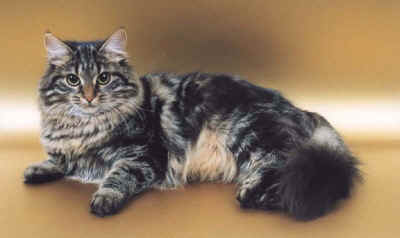 |
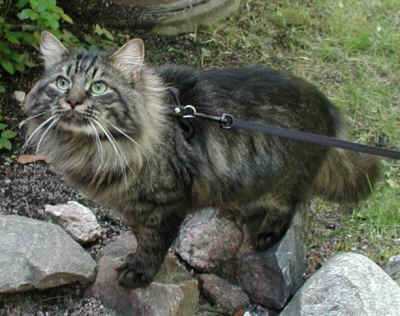 |
| Modern Siberian Cat | Modern Siberian Cat |
The basis of the native breed is determined by the majority of felinologists as the product of the spontaneous selection in the isolated synanthropic population with a common phenotype. Only in cat populations that are sufficiently large and relatively isolated for long periods of time (many decades, or, better, centuries), the genotype is also stabilized. Only such a population can be converted to a native breed without undue difficulty.
The role of artificial selection preceded to the native breed formation can be negligible (NFC, MCO), as well as significant (KOR). The latter considered as "cats of fortune", and even almost sacred animals in their homeland. The pathway of stabilization of the population is thus insignificant, only a long period of any kind of stabilizing selection of either type is required to achieve the genotype homogeneity.
Still, from a geneticist's point of view, any population of synanthropic cats is much more diverse, not to say chaotic than the "normal" biological species. Nevertheless, such a population obeys general biological laws. Knowledge about these rules or patterns, during the breed creation and development, can help to avoid the movement to a wrong direction that can finally bring a breeder to the blind alley (without even alley cats - A. K.).
Formation of the population's genotype (i.e. the sum and the distribution of all genes of the population) is described in terms of matching part of genetics, the population genetics. Knowledge of the basics of this discipline would be very helpful to the participants of the discussion about Siberians and Neva Masquerade cats if they were really interested to figure out some origins of the problem.
Let us start from the rudiments. Where the "Siberian" phenotype comes from, what is a Siberian cat now, and what do we want to see in it in the future?
Some felinologists assume that certain archetypical cats in the past formed the ancestry of many, if not all semi-longhair and longhair cats. The latter were subjected to intense artificial selection. One can note that the fur of truly longhaired cats, such as Persians, is, most probably a product of a long artificial selection. It's hard to imagine that the fur of Persians would confer to the wild or semi-wild cats any advantages during the natural selection. A dense semi-long coat, subjected to season changes is quite different in terms of selective advantage in natural conditions. Obviously, even two centuries ago the human civilization was absolutely different from what is seen now, and the role of nature's factors in the evolution of domestic animals was much higher. Commonly accepted ancestor of the domestic cat is African wildcat, Felis lybica. Given the differences between cats of Middle East origin and classic shorthair cats which are direct descendants of Egypt cats, and, therefore, of F. lybica, and to a smaller extent of Felis chaus (jungle cat), one can assume that semi longhair cats of Middle East acquired a significant proportion of genetic material from other cats. The features such as fur structure and length, solidly built body, and some other phenotype elements are unlikely to evolve within the several centuries in Middle East cats.
A forest wildcat, Felis silvestris, or to be precise, its subspecies is the most likely contributor. Parenthetically, it should be noted that zoologists count more than 20 subspecies of F. silvestris. Best known one is European wildcat whose role in the evolution of domestic cats in Europe is usually negated. However, the habitat of the forest wildcat does not limited by Europe and includes Middle East, Turkey, Caucasus, and partially even more eastern regions such as Iran. Some divergent subspecies of F. silvestris live in India and in Tibet as well.
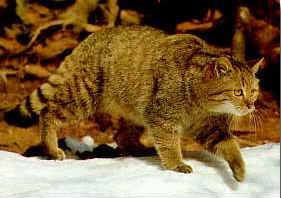
Felis silvestris - European wildcat
The habitat area of Middle East subspecies overlaps with those of F. chaus and F. lybica as well. It is this region, where the major focus of old LH and SLH cats (TUA, TUV in Turkey and LH cats in Iran) is located. This area can be considered as the ancient homeland for LH and SLH cats.
The subspecies of forest wildcat in the Middle East are known as Felis silvestris caucasica. Its fur is dense and contains well-developed undercoat in winter. And that's not surprising. Harsh winters are not rare in Caucasus Minor mountains, and in Turkey and Iran highlands as well. Much of those territories are higher than 1500 meters above the sea level, and in winter nights the temperature can drop to -30°C. The speed of winter winds in this region is also high. Summer, on the other hand, is very hot and dry.
 |
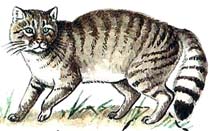 |
| Felis lybica - African wildcat | Felis silvestris caucasica |
That is the reason why F. silvestris caucasica has a semi-long fur with dense undercoat shedding during the warm period. As we can see from the picture, F. caucasica is characterized by a brawny cylindrical body, rounded head with a blunted muzzle, and visible but not accented transition from relatively sloping forehead to nose, quite short massive legs, and a relatively short tail. In other words...reminds quite a lot...yes, a Siberian breed. Is this an accidental coincidence?
Most probably it is not. An anecdote from Soviet-era comes to mind, about the pilferer, who purloined components from the firearms factory, which also produced bicycles or other civilian stuff...doesn't matter, in hope to assemble something for home use, but every time he tried - he got Kalashnikovs... Let him off easy, because this simple anecdote serves as a great illustration of basic genetic postulates and points at the case under discussion as well.
How exactly, the genes defining long fur, emerged in the population of house cats is not known. It is however not particularly important whether wild SLH cats have been domesticated independently, or cats migrated from a major domestication center in Egypt and Asia Minor to the East, acquired the appropriate genetic material from the wildcats on their way. Important is, that as a result, the Siberian cat has a clearly identifiable phenotypical prototype; most probably it is the Eastern subspecies of European forest cat located in the Caucasus and Asia Minor region.
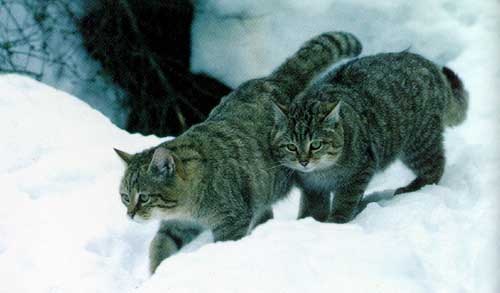
Felis Silvestris Caucasica - picture taken by Russian felinologists in Armenia
Although the fur of the European forest cat cannot be qualified as fully "short", is still hard to compare with dense and hard fur of F. silvestris caucasica. Interestingly, the plasticity of the wildcat is so high that in the mountains regions of Europe, the Alps and Pyrenees, the length of the fur of wild forest cats increases comparing to "classic" European wildcat (see the picture).
It is possible to imagine the ways, by which phenotype of semi long-haired cat has spread from the Caucasian-Asia Minor region further to the East, recreating into sinanthropic animals. Unlike Medieval Europe, the lands of Asia Minor and the Caucasus in 7-14th centuries of Common Era were "blooming". A cat in the Moslem countries is an animal, which is beloved if not sacred. That is why it is safe to assume that cats from Persia and the Arabic world, and later from Turkey have spread with merchants to the east and northeast directions. And, probably they looked very much like modern SLH cats in Russia. As additional proof of this theory is the existence of Bukharian cat, now almost forgotten in Russia, which looks much like both modern Siberian and Caucasian forest cat. Migrating in such a way, together with Moslem population and merchants to the north-east, archetypical SLH cat reached first the regions of Central Asia and Kazakhstan, and from there Volga and South Siberia. And after that, SLH cats have spread further to Siberia and European Russia. It’s highly probable that after Russia liberated from the Tatar yoke, the alternative flow of cats from Europe to Russia increased. But, it happened not earlier than in the 15th and 16th centuries...
Thus, characteristic features of Caucasian forest cat, which allowed it to survive in a continental climate, with harsh winter in the highland forests, played a big role in the modern standard of Siberians. That is why preservation of these features, accenting and unification of these features in Siberian breed would be the wisest way in the breed development.
Currently, F. silvestris caucasica is endangered species placed into the Red Book of the Russian Federation. It is under state law protection in Armenia as well. This fact, which lacks direct relation to the discussed issue is brought for the reason, so I can bring you back to the problem of the behaviour of the population in the process of natural evolution as well as in the process of beginning and development of the breed. When a species is considered as endangered? It happens when the population numbers decrease to a few thousand animals. At this point, the population fate falls under the influence of circumstances that can abruptly change the way of natural selection. In population genetics, such processes are termed as "genetic drift" and "bottleneck effect".
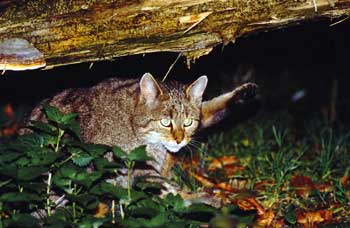
European wildcat
These processes can induce replacement of characteristic population genotype by a totally different one, which was present in the initial population in a very small proportion. In artificial selection within a small population with unknown genotype, it is very difficult to predict selection outcome and, accordingly, difficult to achieve desired stable changes in the phenotype. In other words, the more is the degree of genetic diversity in a small population taken for selection, the less is the chance of its successful "guiding" towards the desired phenotype.
This means, that during selection, towards, for example, a fur color, some other unwanted change in phenotype can happen. These can be changes in the length of legs, the form of the head, fixation of predisposition to a hereditary disease, and other. And the chances of such unwanted effects grow with the decrease in the population size and with each generation born in such population separated from the original gene pool.
After all, let's see how many Siberians of good quality at this time are actively participating in selection in Russia and countries of ex - USSR? Rough calculations made with the help of the Internet show that a number of these animals does not exceed one and a half to two thousand. Besides, if consider that a big part of them doesn't have even theoretical opportunity to mate with each other, and many subpopulations of Siberians are highly inbred, the situation looks even more serious. Although Siberian cats are not under direct threat of extinction, the quality of the mating in their population from the point of view of preserving in the mentioned genetic terms and purposeful improvement of the breed is at the level, which is characteristic for the most dangerous situation, described in the Red Book. There is something to think about, isn't it?
The end of the first part.
We outlined here past and present of Siberian cats and discussed general problems encountered in the development of native breeds starting from the "wild" populations.
In the second part, we turn the attention directly to the situation with Neva Masquerade cats, their relation to the Siberian breed, their origin, etc applying the topics discussed in Part 1.
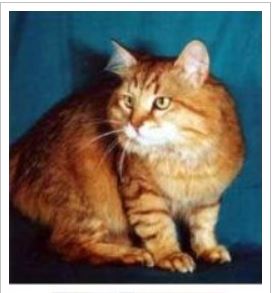 |
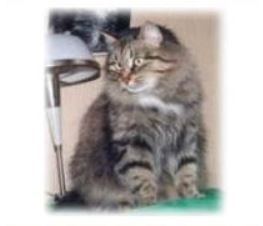 |
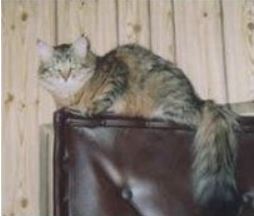 |
| Modern Siberian Cats | ||
© 2003 A. Kolesnikov, Moscow, Russia (English version of an originally Russian article published in the Russian Cat Magazine "Droug" in January 2003. The original article uses partly different illustration).
THE SIBERIAN CAT -The history of love and public recognition.
By Dr. Irina Sadovnikova, WCF Int. All Breed Judge.
Special updated version 2008, with a P.S.
(Reprinted with permission)
This article was written in 2004, published in a Russian cat fancy magazine and after that, translated into several languages, on the Internet. However, some changes had to be made, as life goes on and new developments happen. The recognition of the full color palette of the Siberian cat in CFA was one of them, so the text was slightly changed. I also added a simpler description of the face. But the text also needed postscripts, featuring my thoughts caused by reading recent publications.
The Siberian Cat is one of the most mysterious beings created by human and Nature. Having written this phrase I imagine the reader perplexedly shrugging his shoulders, thinking: what can be mysterious about a Siberian Cat? It would be quite strange even to call it a pedigreed one. Other breeds attract people by their exotic names and unusual appearance - Sphynx, Somali, Cornish Rex... We hear the music of distant wanderings in these names. The proud owners standing behind the cage at the show never hear the words of the kind that each of us, owners of the Siberian Cats, has at least once heard: "Look, this pretty cat looks exactly like our Murka!" Or even: "We have seen such a cat in our yard". But nevertheless... I doubt that any other breed has gone a way from complete obscurity to international public recognition in such a short period of time. I also doubt that any other breed has ever stirred up so many disputes in its native country. Both the origin and many characteristics of the Siberian Cat are treated by felinologists ambiguously.
A large number of works has been written about the Siberian Cat. I would neither like to recur to all of them, nor to pour oil on the dying flames of the dispute. So I will try to speak in more detail about the facts that are not known to the reader or that have been interpreted in a way different from the one we are used to here, in Saint-Petersburg; A little about the origin of the breed; The work that has been done to create its modern appearance; Some breeding problems; International recognition.
A glimpse at history
Beautiful stories are told about the origin of different cat breeds. The Sacred Birman, probably created in France by means of crossbreeding, had received a charming name and a legend about the cats of Eastern temples bound up with it. The Norwegian Forest Cats, originated from aboriginal Scandinavian semi-longhair cats, according to the legend were the charioteers of the goddess Freya. The Maine Coon, a similar semi-longhair cat from the shores of North America, is said to be an offspring of a wild cat and a raccoon. There are also some legends about the Siberian Cats. For example, the one that says they had originated from wild forest cats in the snowy dense forests of taiga and in the Middle Ages guarded the monasteries in Siberia. And it is no wonder - if the history of the Maine Coon can be traced since the 80's of the 19th century and that of the Norwegian Cat - since the 30's of the 20th century, then the written history of the Siberian Cat appears much later. But the name "Siberian Cat" has a really long history in spoken language.
Let us digress for a while from today's appearance of the Siberian Cat, very well known to cat judges and many other cat fanciers. Let us go back to our childhood and try to remember. If we had been asked what a Siberian Cat was and what it had been like, most of us would not have said anything but "fluffy". Someone may have added "large". By method of exclusion we can add "not white" - as all white fluffy cats had been called Angora. But it is for sure that nobody would have characterized this cat as "the one that lives in Siberia".
Dog breeds were quite well known. Cat breeds - rather vague. All cats of the Siamese color were called Siamese. They also spoke of the so-called jungle-cat - if the animal was too wild-tempered. Other "names" of breeds and other ideas about their appearance occurred in some areas. In one village, a home of my friends, all grey short-haired cats with stripes were called rat-catchers and even were selected according to their hunting skills, ostensibly connected with their color. O.S. Mironova mentions the name "Bukhara", used in some Siberian regions for these fluffy cats. Popular conceptions of the Siberian Cat are based on the idea of an animal able to withstand the severe Siberian climate, rather than on its actual origin. "Siberian frosts" is another word collocation which has lost its direct connection with the territory.
The mystery of the origin of the Siberian Cat is mainly connected with the fact that speaking of its history we confuse three different notions: the modern Siberian Cat (a breed with its standard and unique appearance), the popular notion "Siberian Cat" (tracing its roots back in remote ages and being a linguistic rather than feline phenomenon) and the aboriginal semi-longhair cat living on the territory of Russia since the ancient times.
Speaking of the latter, the ways these cats got into Russia and moved further to the North and the East are historical trade routes, such as the one from the Varangian to Greek and the Great Silk road. It is quite possible that the Angora, the Siberian and the Persian had the same ancestors, newcomers from Asia Minor. It is also possible that sometimes they would cross with the wild steppe and forest cats. But it is a mere supposition. Documentary records about cats in Russia are poor; they do not describe these animals. They mention colors of cats, grey cats, but unfortunately not fluffy ones. And later on, when naturalists travel round this country, they pay attention only to the colors. Brehm writes about "a breed of red cats" he noticed in Tobolsk, and Pallas gives a full description and a colored print of a rather sturdy colourpoint cat, one of the three animals of this kind from the litter of a black queen and an unknown sire he saw in the province of Penza. These records are not more than proofs of the existence of cats on the territory of Russia and presence of certain color genes in their gene pool, but not milestones in the history of the Siberian Cat.
* Comments on the latest research on the origin of the domestic cat see in part 3 of P.S.
Creation and development of the breed.
So what is the history of the Siberian Cat as a breed, not just as a semi-longhair cat that lived in Russia? Its beginning dates back to the 80's of the 20th century. It can not be expounded without remembering the first years of the Russian cat fancy.
The Soviet and the Russian cat fancy originated in such large cities as Riga, Moscow and Leningrad. Riga bears no relation to Russia; I mention it here only because this city was the first in the USSR to create a club and to hold a cat show. After that a show was held in Moscow, then in Leningrad. It is quite natural that crowds of cat fanciers with their pets poured into the first clubs. Cat books with colorful pictures had appeared long before and each cat owner examined his pet to find the features resembling these pictures and romantic descriptions. I still remember how desperately I wanted my first cat to be called Norwegian, because I had read in a quite serious book that only these cats climb down the trees like squirrels, head first. My kitty really did so climbing down a pine at our country house! But when I brought my green-eyed torbie, grown up from a dirty dag found in the back-yard of the tire factory, to the club, they said it was a Siberian Cat. (They would also find "Maine Coons", "Norwegians" and "Balinese" cats in those yards and near rubbish cans... However, most of these cats had never managed to overcome the hurdle of the Novice class. Some remained household pets; some were accepted as Siberian Cats by the judges).
* Look for update on "Balinese" in P.S. below (Part 5).
At that time the idea to create a Russian breed was up in the air. And of course it should have been called "Siberian Cat", due to the long history of this word collocation. But the appearance of this cat had not been obvious yet. It must have been semi-longhair, but what else? Type, size, shape of the head, muzzle contours, placement of ears - a wide variety of these features was represented in the urban and the suburban population of semi-longhair cats (let us call them "conventionally aboriginal") studied by felinologists. They had to make choice on the basis of the predominant type in the population, taking into account already recognized breeds of semi-longhair cats, mainly the Maine Coon and the Norwegian Forest Cat. Everybody wanted to refrain from the repetition of the existing things.
** Look for update on "archetype" in P.S. below (Part 2).
The first standards of the new breed were created in the late 80's by the felinologists of the "Kotofei" club (O.S. Mironova, I.J. Katser, etc.). At the same time the Siberian cats were registered and bred by other Russian felinologists. In Moscow this work was being done by T.S. Emelyanova, L.K. Ovchinnikova, T.D. Sapozhnikova. But it was "Kotofei" that wrote the standard. The legendary Siberian stud Roman, born in 1987 (owner A. Ivanova, "Kotofei"), was taken as a model. He was one of the foundation cats for the breed.
*** Look for update on the first Russian felinologists in P.S. below (Part 4).
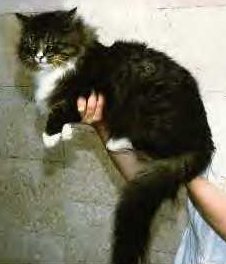
Since the very beginning the following features have been emphasized: powerful type, solid bone structure, round paws, full rounded muzzle, ears set wide apart and oval eyes. The shape of the head was specified as rounded. The size was slightly exaggerated by the standard. If the text of the 1989 standard resembles a romantic description, then the standard of 1990, keeping almost the same body parts also includes the colors (agouti, agouti with white, non-agouti, non-agouti with white and colourpoint in the same groups) and the faults.
The SFF, which at that time was called the Soviet Felinology Federation, accepted this standard. In 1991 the first international standard was worked out on its basis. The WCF, being a young international federation at that moment, was the first to admit the Siberian Cat, including the Siberian colourpoint. Another famous foundation male, Mars, a blue tabby point with white, born in 1988, belonged to "Kotofei" too.
Mars and his son Nestor can be found on hundreds of pedigrees. Nestor is a founder of the bloodline of the "Gel" cattery. His blood was also used in the "Marcell" cattery in combination with Roman's line (which later turned into the lines of Vergiliy and Lucreciy). "Kotofei" has also brought up other foundation cats later used in new clubs.
I have the yellowed catalogues (mainly in the course of time, but some - with the help of cats) of the first cat shows in front of me. Let us try to find Siberian cats there. Before 1991 the owners entered them into various breeds and groups:
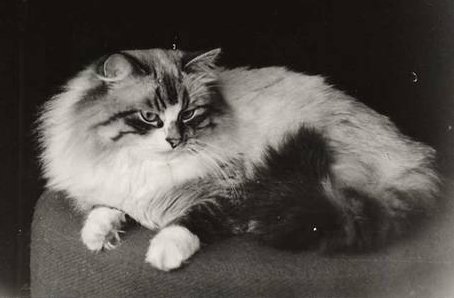
1989: Moscow, May 8-9.
The first All-Union cat show. 190 animals in the catalogue, good few are Persian. The section "Longhair and semi-longhair cats of unknown breeds" includes 12 Siberian Cats. All of them have no registered parents. However the section "Household cats" is more extensive. We see here Mars for the first time, on the supplementary list. He enters the Novice class as a Siberian Cat at his next show and becomes a stud.
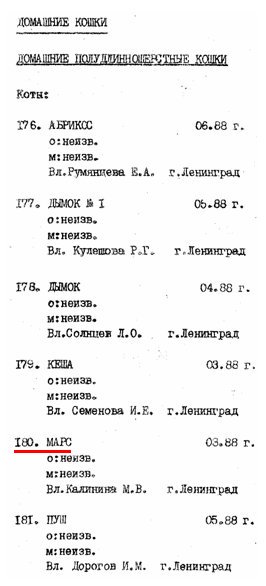
1989: Riga, September 23-24.
164 cats in the catalogue and again almost half of them are Persian. The section "Officially non-recognized breeds" includes the Siberian and the Neva Masquerade. Number 146 in the Novice class is the famous Roman. In the Open class we see the former novice seal point Ricky, who later gave birth to many offspring together with Selina. And Selina appears in the Novice class as... Balinese! She is transferred to the Siberian breed at this show. Many pets go through this way if they start in the Novice class.
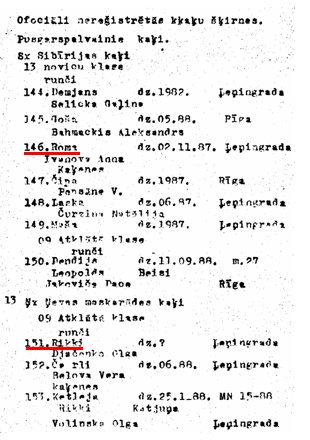
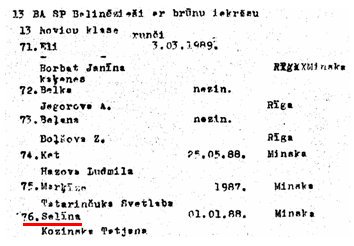
1989: Moscow, September 7-8.
244 cats in the catalogue. The Siberians are included as a breed group, there are 26 of them. Cats from Leningrad are simply not included into the catalogue at this show. But then we can trace the destiny of the "Balinese" male Boyz, born in 1988, who had been found with his elderly mother and sister of the same color in Samara by Irina Gorinova. Boyz, who had also been transferred to the Siberian breed, was successfully shown later, and lived a long life.

On the 16th of September 1989 a group of breeders from Leningrad and Moscow applied for the registration of the Siberian Cat to the SFF, established in April of the same year. The breed is registered on August 6, 1990 (Certificate №1). At the same time the colourpoint Siberian Cat is registered as a unique color variety of the Siberian with a second name "Neva Masquerade" (Certificate №2). Now the show catalogues of the clubs cooperating with SFF should include the Siberian Cats in the semi-longhair section with a separate group of colors "Siberian Colourpoint (Neva Masquerade)".
The show of the "Kotofei" club, January 5-6, 1991. 342 cats in the catalogue. 119 Siberians, including 29 colourpoints. The Novice class includes 50 Siberians, with 13 colourpoints. The eldest cat is nearly 10 years old, but she is shown in the Novice class. There are lots of animals of the first generation with birth certificates (no pedigree certificates yet: to get a pedigree certificate instead of the birth certificate, first generation progeny should have been evaluated by judges). Offspring of Roman, Mars and dozens of other former novices.
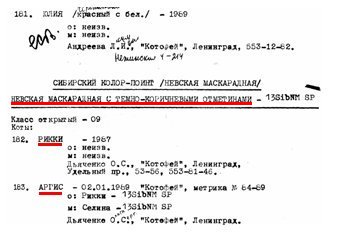

Despite the ample quantity of pedigree material, the stock of the early 90s had much to be desired. The litters "fell to pieces". Only devotees dealt with the Siberians... Many clubs and even judges sneered speaking about them. But at the same time the interest to the Siberians abroad grew in leaps and bounds. If the animals which had earlier been exported to East Germany and Czechoslovakia were those "popular" Siberian cats without any standards or documents (by the way, they are the founders of some European lines of insufficient type), then the export of the early 90's consisted of the first and the second generations of the Siberians, the results of breeding. The offspring of Roman were imported to the USA by Elizabeth Terrell of the "Starpoint" cattery.
The "Starpoint" lines are still highly valued in the US.
A considerable quantity of cats of different colors was imported to Germany by Hans and Betty Schultz (the "Newskij's" cattery), who played a great part in the popularization of the breed in Europe. Newskij's Magadan Terranka, a male bred in this cattery, could compete at shows even nowadays. But still, the first wave of the exported Siberians was on the whole of poor quality. It resulted in the situation, when each breeder or cattery owner tried to create his own standard for his stock. At that time some foreign judges thought that the Siberian Cat is not more than a poor type Maine Coon. Or even a cross of the Norwegian and the Maine Coon. All these breeds have a similar coat structure with slight differences; they all are quite large and sturdy. It was not a simple task to find distinctions in their size, length of the legs and of the tail, and shape of the head stated in the first standards. Although the draft standard of the WCF in 1990 was based on the one by "Kotofei", in 1991 the first official standard underwent some changes: high cheekbones were mysteriously added to the rounded shape of the head and the tail was to be long to very long - it indeed resembled a poor Maine Coon. Especially taking into account the fact that it was very difficult to find ideal representatives of both breeds in Europe.
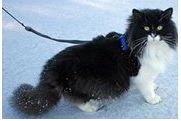 |
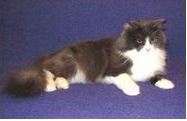 |
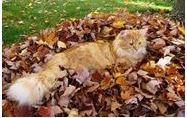 |
| Lundberg Zorro | Windrifter Larisa | Birchgrove Toyla Taigovich |
The distinctive features of the Siberian Cat had to be emphasized in the standard to win the public recognition. These characteristics had to be found and fixed in the breed to create a unique appearance. The stress was made on the head shape. Broad low cheekbones connected by a gentle line to a rounded muzzle could not be confused with a head of the Maine Coon or the Norwegian Forest Cat. For the first time these features were described in the Leningrad/Saint-Petersburg stock and included into standard by PFS (I. A. Okulov, E. J. Dmitrieva) in 1991.
A large group of females had been selected (for example Frazy, Roman's granddaughter, Gladys, daughter of Mars, Pyshka born in 1988, who later became one of the first Siberian cats - World Champions) and two males, the closest to the demands of the new standard (one of them is Georgiy, born in 1987, used to found the "Knyaz Gvidon" cattery).
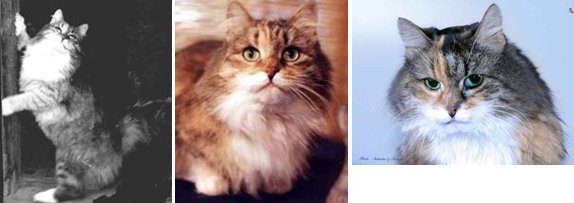
However, these males did not show prepotency. But the idea was followed by luck: a new foundling appeared in the club, a cat "in a poke". An old lady has brought her pet in a bag! It was the male Max, born in 1989, a large powerful cat of seal tabby point color with almost ideal contours of the head and nearly perfect coat, just a little too short. He was the one who proved to be prepotent. So prepotent, that up to the present moment his female offspring in the third and fourth generation give birth to his little copies of all recognized colors.
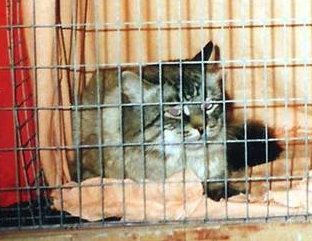
His line, began by the "Nightingale" cattery, is continued by the catteries "Dikaya Krassa" and "Dom Filina". We can already speak about the success of his sons' (W.Ch. Arsenij Nevski and Gr. I. Ch. Filimon) lines. This head shape was soon included into the WCF standard.
In 1994 at the IFSJ seminar the same cheekbone and muzzle contours were used in the composition of a more detailed standard than the PFS one. The shape of the head was specified as "trapeze". This standard was published in the collection of standards of aboriginal breeds, at present it is valid in the SFF and has no significant distinctions from the today's WCF standard. We find "short broad trapeze" in the SFF standard, "short and broad head" in the WCF standard, the cheekbone and muzzle contours have the same description. The length of the tail is set according to the heavy type of the animal: "medium" in the SFF standard, "to the shoulder-blade" in the WCF standard.
The further breeding of the Siberian Cat in Russia is described in detail in many publications. The creation of the Union of Siberian Cats' Fanciers in Moscow (late T.E. Pavlova) has contributed to the popularization of this breed in many respects. This union successfully holds monobreed shows and keeps a record of those Siberians who became World Champions.
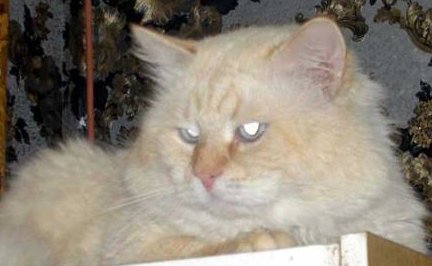
It is not that easy to get cats of a good modern type. If the work on the type is based on line breeding, the cats within one cattery will soon be of the same type with not only merits, but also faults fixed. The exchange of the breeding material between Russian catteries is still insufficient. And if it does take place, then mainly for the purpose of adding a new color or "diluting" the inbreeding. Each cattery is satisfied with its type, which is justified in many respects. Fortunately the poor type elongated Siberians are gradually becoming things of the past. Many catteries achieve great success in body conformation. Large, heavy animals with powerful legs and big round paws can be seen much more often now. Besides that such attractive colors as golden and silver were obtained and fixed.
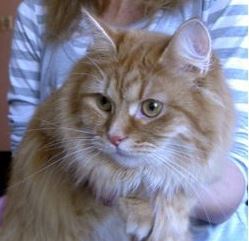 |
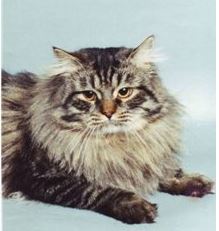 |
| Olisia Laskovy Zver' | Bay Sultan Laskoviy Zver' |
The most problematic moments are the coat quality and the shape of the head. As to the latter, if we put aside long narrow heads, pointed or narrow muzzles which do not comply with the standard at all, then the most difficult task is to achieve the right shape owing not to soft tissues, but to bone structure. The standard on purpose accentuates the fact that the roundness of the facial part depends on cheekbone arches and on the full muzzle, but not on full cheeks. This moment is essential to exclude the undesirable type, close to the semi-Persian.

Among these pictures there are two Siberian cats. Can you find them?
Answer at the end of this section!
The main features of the desired and the undesired type of the Siberian Cat:
| Undesired type (too slender) |
Desired type | Undesired type (Half-Persian) |
|
| Head shape, cheekbone outline |  |
 |
 |
| Forehead and profile shape |  |
 |
 |
| Coat texture | Not connected to the slender type |
 |
 |
| Eye aperture |  |
 |
 |
The cheekbone arch of the ideal Siberian Cat extends to the outer ear base, and the one of a cat of the undesirable type - to the mid-ear. The distance between the canine teeth of the Siberian Cat is large; the lower jaw arch between the fangs is nearly straight. The animal of the undesirable type has a sharper arch and the distance between the canines is short. Optically such a head seems rounded due to the full cheeks and the developed soft tissues of the muzzle. The bone structure of the ideal Siberian is easily palpated; even the cheekbones of a cat in full coat are well seen. If we add the difference in the skull height (an ideal Siberian Cat has a lower skull), the shape of the forehead (an ideal Siberian Cat has a smooth dip from the flat skull to the straight broad dorsum of nose, accented by the direction of the hair growth), the coat texture (the cats of the undesirable type have an overdeveloped undercoat and on the contrary, their top coat is too fine) and the shape of the eyes (the upper lid of the Siberian Cat must create an oval shape of the eye), and often lower placement of the ears, then it is easy to withhold the certificate. Of course not all of these features are present at the same time. That is why cheekbones are worth paying attention to.
To put it in short simple terms: the broad face of a Siberian cat is formed by broad low cheekbone arches, well distanced eyes and a broad nose. The full muzzle is formed by a broad lower jaw with a lot of width between the canine teeth and rounded whisker pads. The profile is formed by a flat forehead, raise at eyebrow level, shallow dip at nose bridge, a straight nose, and a rounded chin.
The inclination to get more decorative cats is often characterized by a longer coat, sometimes together with the changes in its texture. Unfortunately too soft coat is frequently met, not only in dilute colors and some lines of colourpoints, but also in black silver and what is even stranger - sometimes in plain black tabby. The position of the judge is of great importance here, namely the preference of the appropriate texture with firm oily top coat to the length and especially to the color and pattern. Taking into account the fact that both color and pattern can be given not more than 5 points, the cat with indistinct pattern or dim color without any faults in the type, shape of the head and coat texture, can virtually win the desirable 98 points. Faults in the coat texture (up to 20 points) are to be more strictly penalized, especially if it is an overdeveloped undercoat or absence of the typical waterproof top coat. It would lead to more strict selection according to the coat texture in the catteries.
The same inclination to decorativeness sometimes results in the eyes too wide open, nearly round. It is better to keep to the golden mean here. The eyes of the Siberian Cat should be set wide apart, they should be rather large, but not round. Deep and close set eyes are just as inappropriate for a Siberian as round, wide open ones.
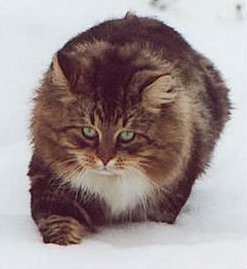
Fiodor Della Niva, Italy
Answer: Cat # 1 is a pedigreed Siberian cat of slender type,
Cat # 3 is a pedigreed Siberian cat of hypertype,
Cats ## 2 and 4 are pedigreed Persian cats of "doll face" type.
Siberians abroad.
In America they had changed the standard in their own way, however, understanding that there should be as many distinctions from similar breeds as possible to win the recognition. It was expressed in the preference of rounded shapes in all the sections of the standard. Head, eyes, belly of an American Siberian should be nearly round, and special attention is paid to the low ear set. On the contrary, the standard does not specify the cheekbones. The best catteries, truth to say, still come to 'our' type of the modern Siberian. Siberian cats have a full championship status in the TICA and the CFA.
In Europe the stock had been very diverse for a long time. Poor type with long legs and tail, elongated muzzle and high cheekbones was quite widespread. They even came to oval paws and absence of undercoat, stating the latter in their "new" standard. But in the recent years the appearance of the Siberian Cat in European countries has become good enough. Reasonable import in combination with well thought-out breeding bears its fruit. And again an interesting trend - despite the distinctions in standards (in the FIFe standard they had a long tail and high cheekbones until 2006) the best cats have our modern appearance.
Unfortunately, both in the USA and in Europe there are catteries keeping to the idea of roundness too closely, where cats look too much like the old traditional Persian. This is a detrimental tendency, as it works against the original idea to select for a cat of unique distinct appearance.
There are very few European countries left where nothing is known about the Siberian Cat. The Siberians have recently come to Great Britain, though this island had been closed for them for some time. Several generations of good Siberians have already been born there. And on September 8th, 2004, we got to know the good news: presentation of the Siberian breed at the meeting of the GCCF Executive Committee got crowned with recognition! The GCCF standard is more detailed than the WCF one, but at the same time it is the analogue of our standard in terms of type and recognized colors.
Now the Siberian Cat can be found in any part of the world, except for Antarctica. There are catteries in Japan, South Africa, South Korea... The Siberian Cat has won the world in a split second and is going to hold its positions.
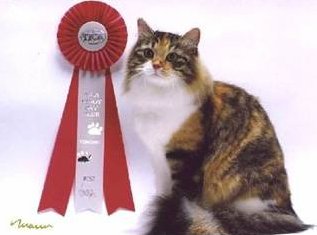 |
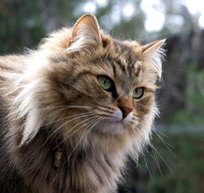 |
P.S. Seven PostScripts
Part 1: Hypoallergenic cats
Another development was screening a group of Siberian cats in the USA for Feld1, a known allergen. In the original text of the magazine article I had a short part devoted to the alleged hypoallergenic qualities of the Siberian cat. At that time we could only quote success stories and hypothesize; now we have a leg to stand on.
Siberian Research Inc., (a not-for-profit association of Siberian breeders) has tested a number of Siberians for Fel-d1 levels in both fur and saliva (http://siberianresearch.org/about-allergens.htm). Results showed many Siberians have lower levels of allergen than other breeds, and offspring from tested low-allergen cats were less likely to cause allergic reactions than offspring from other matings. No correlation was found between colourpoints and allergen levels.
Part 2: Archetype of the Siberian Cat
One more development has been the steady growth of interest in the origins and development of the domestic cat, with interesting articles being published. A most interesting article by Dr. A. Kolesnikov (The Siberian cat - part I-III) often uses the notion "archetype of the Siberian Cat". The word is, in fact, strikingly suitable to talk about the Siberian Cat, as its meanings suggest:
- the original pattern or model from which all things of the same kind are copied or on which they are based; a model or first form; prototype.
- (in Jungian psychology) a collectively inherited unconscious idea, pattern of thought, image, etc., universally present in individual psyches
And in biology:
- a primitive generalized plan of structure deduced from the characters of a natural group of plants or animals and assumed to be the characteristic of the ancestor from which they are all descended
- original ancestor of a group of plants or animals.
In all meanings, obviously, "archetype" is a construct, something that doesn't exist in reality, but may have existed in the past. However, it is only by speculation that we can re-create this archetype. No one has ever been able not only to study the mediaeval remains of domestic cats on the territory of Russia, but also to see a picture, or read a detailed description. The appearance of the Siberian cat has followed an "archetype" in many meanings, and the "Jungian philosophy" one is among the most important of them. As mentioned in the beginning of my article on Siberian history, it had been dictated not only by the type predominant in the urban and suburban population, but also by the general idea of a big frost-resistant cat, and, as regards head shape, by distinct features, vitally important in order not to be confused with already existing breeds. The frequent presence of colourpoints among the original alley cats and pets to be included into foundation Siberians reinforced the distinction idea in colors, too. Quoting Dr. Kolesnikov, "[the first Russian felinologists] captured the breed's archetype features common both for big cities and for Siberian backwoods". He also illustrates his idea of the existence of such archetype by similarities in the phenotype of cats after "a plethora of outcrosses between cats from different locations". I wonder if identical phenotype similarities would be reason enough for the author to agree that descendants of lines bred for type without excluding colourpoints have the same archetype?
A test for unprejudiced readers: please decide which of the males shown in the pictures have multiple colourpoint ancestors? (Answer at the end of article!)

Part 3: Origins of cat breeds
An important milestone in understanding the origin of domestic cats was "The ascent of cat breeds: Genetic evaluations of breeds and worldwide random-bred populations" by Monika J. Lipinski et al. This article, on the one hand, shows the result of genetic analysis that (quote) "clearly delineated four genetic clusters of cats, corresponding to Europe, the Mediterranean basin, East Africa, and Asia".
Interpreting these results, Dr. Kolesnikov stresses that "the most important is that recent molecular genetic analysis unequivocally demonstrated that Siamese clad of cats (in which Thai cats represent one of the archetypes) is genetically most distant from the rest of the cat breeds as well as from European and Mediterranean alley cats [4]. Siberian cats included in that study represent no exception and are located at the opposite branch of this genetic tree". He also attracts the attention of the reader to the fact that Persian cats lost their region-specific genetic features, and are now closer to the Western than the Mediterranean cluster.
On the other hand, the researchers also state:
- that the next separation after that of the South-Eastern cats occurred between the tight cluster of Western European cats and dispersed groups of Mediterranean, North Asian and East African cats;
- that the Siberian cats are genetically close to random populations of Western Europe (ibid). This contradicts the hypothesis about Iran/Caucasus/Siberia as the sole points of origin of the breed.
The quoted article also mentions within-breed heterogeneity of Siberians and states that several breeds have multiple lineages: "Five breeds (British Shorthair, Exotic Shorthair, Norwegian Forest Cat, Persian, and Siberian) showed subdivisions within each breed, indicating multiple lineages". Within-breed heterogeneity of the Siberian stated by the researchers shouldn't actually be surprising taking into account the sheer size of Russia.
Putting aside the artificial breeds, to which the British Shorthair should at present be also counted, we are left with the Norwegian and the Siberian - shouldn't we suppose they are relatives who, incorporating multiple (but probably not identical) regional peculiarities, had gone a long way alongside each other before being separated? And isn't this multiple lineage the reason for genetic diversity, as shown in Fig. 4 of the quoted article - NFO are the second most genetically diverse breed after Siberians? And isn't genetic diversity an asset for breeding? At least, this is what the authors of the article think.
This research didn't involve European Shorthair cats. I have a strong suspicion that in Russia they would show multiple lineages, too.
Part 4: "Amateur Argonauts rushed into a felinological fleece search"
As obvious from the quotation taken from the second part of Dr. Kolesnikov's article, he consistently claims a "lack of systematic education of first Russian felinologists" which of course should be compared by the reader to the profound felinological knowledge of a Ph. D. in biology. Let me introduce the Argonauts who were involved in the creation of the Siberian standard in St. Petersburg:
Olga Mironova deserves to be mentioned first. The reader might not be aware that she is a medical doctor, with a medical education and a course in genetics under prominent specialists in this sphere. Later, Mrs. Mironova got involved into dog fancy. Unlike cat fancy, dog breeding, judging and training had been supervised by the Soviet state for obvious reasons - police service and border guarding. DOSAAF, the Soviet society promoting assistance to the Army and Navy, was the governing body of dog fancy clubs. It means that education for dog judges and breeders was on a high level both in theory and in practice, characteristic of Soviet education system. It involved animal husbandry, zoo culture, genetics and a profound multistage judges training. Mrs. Mironova qualified as a judge and had been judging dogs for quite a long time before transferring her knowledge and expertise to cat fancy. She founded Kotofey, the club that started the work on the Siberian standard. She has been giving seminars and educating Russian felinologists rather than being educated by someone in cat fancy.
The head of breeding committee in Kotofey was Ph. D. in biology Elena Dmitrieva. A research scientist at St. Petersburg State University, she read genetics to Kotofey members and later to a new club, PFS, whose President she was at the time when the Siberian standard got its distinct head description (see the standard history above). It was under Dr. Dmitrieva that Max, a seal tabby point foundling, was selected as the prepotent foundation stud and the breeding program was developed, producing hundreds of standard type cats. Unfortunately, Dr. Dmitrieva has lost connection to cat fancy due to personal reasons, but her lessons are remembered by her students in felinology.
Some amateur Argonauts...
And taking more recent specialists with biological background who fully support the features and the color palette of the Siberian Cat, why not look at Dr. Yanina Melnikova from Minsk? A molecular geneticist, who has an education as a judge. Not only a WCF judge, but also CFA guest judge, moreover, one that gave seminars in genetics for CFA.
Part 5: Balinese and their likes
It often happens that people, reading from the same source, can come to totally different conclusions. Here I must contradict Dr. Kolesnikov, who mixes up two notions:
- unpedigreed cats, having no registered parents, whose owners WANTED them to be registered as Norwegians, Maine Coons, Balinese, whatever, and
- novice cats that got ACCEPTED as representatives of the said breeds and were used in breeding.
What is so surprising in the video that Dr. Kolesnikov describes? I know dozens of cases when people mistakenly thought their pets belonged to a special breed. Even now, talking to pet owners, we often meet such ideas. While I am working on this article, the plumber repairing my bathroom tells me stories about his "Norwegian cat", of course without papers and of local origin. Whatever I try, I cannot convince him that his cat only looks somewhat like a Norwegian. In the early years of Russian cat fancy it was very easy to enter a cat of unknown origin into novice class under whatever name it seemed to be flattering the ego. Nothing but wishful thinking.
I must repeat that all these novices went different ways. Some stayed pets; some got transferred to an aboriginal breed: obviously type and coat dictated the possibility of being suitable for Siberian breeding; but Angoras were also plentiful among accepted novices. Norwegians and Maine Coons were isolated cases. Especially in Riga, many alley cats were used to start Maine Coon breeding. By now, this breeding has practically stopped. As for Balinese, there were no known cases in St. Petersburg when a novice has been accepted as a Balinese - for the reason of absence of Siamese type. If somewhere any SLH colourpoints of unknown origin had been included into a Balinese breeding program, after having been used in Balinese breeding, they could not have been transferred to the Siberian breed any more. Let me remind the reader of the fact that only novices can be accepted or transferred to another breed by phenotype, NEVER cats with registered parents...

Mitrofan Dikaya Krassa,
SIB n 21 33.
Part 6: The Colourpoint waves
Firstly, speaking of Thai cats, can I remind the readers that there had been no Thai cats as a breed until even later than the Siberians had been recognized? We are talking here of shorthair alley colourpoints. As in any random population, there are different types there. Some can be heavy and large, others elegant and refined. When Thai were being developed as a breed, the source was the random population with medium light boning; however, there were cats with medium heavy and heavy type, and felinologists didn't even dream of using them as Thai! SFF recognized European Shorthair in the cp variety, just because there were plenty of this type shorthair cp cats, too. This, however, didn't find wider recognition, because the European Shorthair was not a breed developed in Russia. So the "Pallas" cp was not a Thai cat... Nor was it a Siamese. It was an alley cat of unknown origin, of sturdy type (look at the boning!) characteristic for Russian aboriginal cats, but of a different color. Being born from a black cat means the presence of the gene in the population in a recessive form. How it got there - is a question that can't be answered at the present level of knowledge. But by being there for such a long time it is no more alien to the population than any other mutation different from the wild black tabby phenotype.
There is nothing to argue about when we talk of the origin of the colourpoint mutation. The chance of an independent mutation away from South-Eastern Asia is quite remote, but this is not relevant. The core of the argument is: How far behind in time must a mutation lie, how far behind in time must it have reached Russia for Dr. Kolesnikov to count it to the aboriginal gene pool? Cats carrying it must have appeared in Russia, besides, early enough to not include the b and bl alleles, which have never been present in those alley colourpoint cats in Russia.
Genetic geography shows that the origin of the classic tabby mutation is on the British Isles. Shall it be considered as un-Russian? It is just one of plentiful examples of how far we can carry the evaluation of what is alien and what is not.
In my humble opinion, a breed developed on the basis of Russian SLH alley cat population can be allowed to possess all genes this population has had by the time when breeding started. I have never seen any reasons for either adding or removing colors. Unless one wants to create something really different from the existing breed, a cat that looks like one of the wild species. In this case, however, not only colors should be different...
The first "wave" of colourpoints has come to Russia centuries before Obrastsov's cats. Moreover, if one considers them to be the cornerstone of the introduction of the cp gene into SLH population, why, then, were they so plentiful in the 80's in St. Petersburg and quite rare in Moscow, where the original pair of Obrastsov's cats had lived? The obvious answer is the more frequent presence of this gene in the recessive form in St. Petersburg. Was it due to the city being a sea port? Then why was the other place of frequent appearance of cp SLH Samara and not Vladivostok? There is some probability that Obrastsov's cats have contributed to the spreading of the gene, but it cannot be the sole reason for this.
What is more, the speed of cat reproduction suggests that not only the first introduction of the cp gene into the Russian cat population had been "diluted" and "digested" by hundreds of generations, but also the re-introduction via Obrastsov's cats lay at least between 12 and 20 generations before Siberian breeding started.
If we speak of colourpoints appearing within the Siberian breed, the real first wave was formed by the alley cats taken out of the street population to start breeding. They differed from their non-cp brothers and sisters only in color.
The "second wave" has taken place not in the way suggested in Dr. Kolesnikov's article, as explained in part 5. If the author means erroneous recognition of several non-pedigree cats as novice Siberians by some uncritical judges, then I do agree - but why should they be regarded as results of Balinese breeding? They were mostly pretty fluffy kittens bought in the market without papers.
The "third wave"... Here I tend to agree with the author. There have always been and will always be attempts to outcross, and we have some results of those attempts in non-cp's as well as in cp's. The thing is that we must join forces to eliminate these results from breeding stock, whatever the color. This can only be done by judging type and coat texture first and foremost.
Part 7: Recessive and dominant color mutations in breeding
I must first mention that silver has been introduced into Siberians in the same way as all other recognized color mutations: by random matings within alley cat populations. It had been there by the time of the start of planned breeding, same as colourpoint. Introducing silver from a different breed would be thus unnecessary, harmful and not allowable by any cat fancy federation. The same concerns purposeful introduction of the cp gene from another breed. This gene, however, has also been there, and also in the most "archetypal" Siberians I have ever seen.
Trying to make out what the real danger of the cp mutation is, I have stumbled on a recommendation showing how to work with dominant traits introduced into the population: explaining that silver can be bred in using one ancestor (which, as I see it, results in steadily increasing inbreeding) and that it is easy to monitor the undesired traits. Did I get it right that the undesired traits seen by the eye are phenotypical features, like type, coat etc.? Then what is the difference between the recommended control and the usual monitoring of the type, coat etc. in all progeny done by all breeders?
Type and color are not related. A dominant color mutation is accompanied by all other genetic traits (present in the cat introduced into breeding) influencing type, coat, health, etc., which can be recessive, dominant, show incomplete penetration or be polygenetic. There is no connection between the ways these traits are inherited. For breeding, a non-silver cat obtained from a heterozygous sire can be as good or as bad in type as any silver cat. It won't be used for breeding silver, but it can be used for breeding other colors. What intermediate progeny should be eliminated? Intermediate phenotype? How can body conformation and coat texture depend on a recessive or dominant nature of the color mutation?
Every breeder monitors the quality of kittens. No breeder can "read" the complete genotype albeit a dominant or a recessive mutation. Where does the danger lie? In the inability of the breeder to see if the acromelanistic gene is carried by a non-cp cat? This can be cared for by a simple test. Or in the inability to understand what traits are going to influence the type? No difference here between a dominant and a recessive color genes. Does anyone believe that if a long-nosed silver cat has been used for breeding, it is easier to eliminate the poor type it produces than if one uses a long-nosed colourpoint cat?
Any time a breeder gets out of his own lines, which is unavoidable if one doesn't want to sink in inbreeding and incest, there is a risk to get an incompatible line and ruin the type. Even if you have been breeding red spotted cats for years and are adding a red spotted from an unrelated line, you might get unexpected poor progeny, which has to be eliminated from breeding.
Does the danger lie in anything harmful genetically linked with the cs gene? We have yet to learn that there exists something like that. Quite improbable, by the way, otherwise the cats bred for ages (Siamese, Birmans, Ragdolls, etc.) would all have been harmfully affected.
What is the reason for the recommendation to control genetically all heterozygous cats from a cp/non-cp mating? To be able to avoid getting cp kittens? Then why use a cp at all?
For me, it is an obscure vicious circle, without any other reason but the conviction that the cp gene is alien... and that's what I have been contradicting for quite a while already. Taste and stereotype thing, actually.
Can I repeat what I said above? Why don't we join forces to promote Siberians with the standard phenotype in all colors instead fighting absolutely anything which differs in opinion?
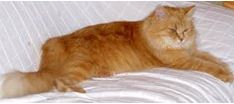 |
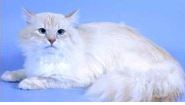 |
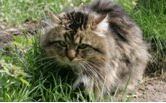 |
| Three generations: | ||
| GICh Alionka Dikaya Krassa | WCh Iz Ermitage Hirdon | Platon Dikaya Krassa |
Answer for the unprejudiced reader:
Cats ## 1, 4, 8 and 10: Black tabby males, colourpoint carriers, with several colourpoint Siberians on the pedigree.
Cats ## 2, 3, 7 and 9: Black tabby males without any colourpoints in the lines.
Cats ## 5 and 6: Seal tabby point males, from colourpoint only lines.
All these cats are Siberian males from different countries with Russian origin, displaying striking similarity and stability of standard type, with broad low set cheekbones, massive muzzles and mild profile lines.
© 2008. Irina Sadovnikova, WCF Int. All Breed Judge.
Siberian Cat:
How Long The Isolation Is?
Part II.
Official birth of Siberian breed is dated to more than 18 years ago. Although the breed can be still considered as "young", the time span of almost two decades is well enough to retrospectively analyze some key points of SIB development and to dissect important trends, both favorable and unwanted, affecting the breed evolution and causing nowadays some quite complex problems.
That it was sometimes almost natural evolution rather than careful selection, can be proved by a number of quite different SIB types existing around. When selection took place, it was often directed towards some secondary features, e.g. towards color in lieu of breeding for consistent type. One is the most problematic issues is therefore significant differences between Siberian standards in major world cat associations. Siberians have been recognized in these associations in different times, and at different stages of breed development. Now it is not surprising that each cat system, each cat club, or even each cattery possesses SIB "vision" of its own.
At the beginning of "rational" SIB breeding, in late 80th and early 90th, there was some type of consensus statement regarding SIB type achieved by Soviet, and then Russian breeders regarding the SIB type. That consensus statement could be barely called a standard, just because very few (if any) professional felinologists and breeders existed then in USSR and Russia. As the result, the consensus statement has been strongly influenced by the opinions of the cat professionals from abroad, not because those people wanted to be the authors of SIB breed or standard or whatsoever, but only because of their authority due to long-term experience in felinology. Also, the attitude to SIBs (still existing and rather widespread) as to "just alley cats" took its toll. Unlike, for example, NFOs, initially SIB breed has been mostly developed by rather naïve amateurs who had moderate (to say the least) experience in felinology, and even less experience in genetics and setting up breeding programs. This is not for the purpose to state that all the people started to breed Siberians were one and all ignorant, but to underscore that the proportion of professional breeders and felnologists was unacceptably low, and they often acted separately from each other. This has led, for example, to such a big abyss between Moscow and Saint Petersburg Siberians.
What had helped to the breeders substantially at that stage, and before Siberians has become relatively widespread and uniform as the breed, was the fact that centuries of natural selection in Russia, especially in geographically isolated regions of Siberia and Far East, did result in a cat with a number of common and rather genetically stable features. Till now, such cats can be easily seen in rural areas just few tens of kilometers far from Moscow, not to mention Siberia and north of European part of Russia.
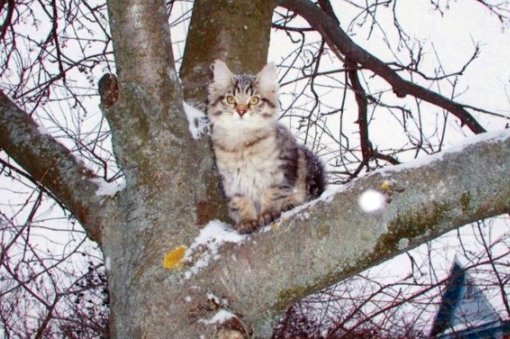
1. Rural kitten near the town of Dmitrov, 60 kilometers to the north from Moscow.
The achievement of early SIB breeders and standard writers crucial for the further breed development, was that they succeeded to capture at least some of these stable features and considered them as the breed characteristics. It was therefore knowledge-based coincidence of natural genetic background and some important "written" breed characteristics that was helped to maintain SIBs in the state of recognizable breed rather than scattered population of alley cats. Time and again I hear statements that Siberian cats have nothing in common with Siberia, that they are just alley cats of Moscow and Saint Petersburg, and they are merely an artificial breed like, say, any Persian or British Shorthair cat. It is wrong and dangerous statement, which purpose is not obvious to me. Best SIBs I know, including the famous Abakan line, Treskuchii Sibirskii Moroz Mur (Irdie), a number of remarkable cats from Krasnoyarsk, Siberia, and some other were in fact the offspring of outcrosses between the cats from European part of Russia and those from Siberia or Far East. In the case of Saint Petersburg, where cat population has been artificially restored after WWII and 900 days of siege, such outcrosses occurred naturally when cats brought from Siberia met those re-introduced from other parts of Russia. That the purposeful outcrossing of few cats of similar type and mostly known history differs from immediate arbitrary mixing of large numbers of totally unrelated cats with unknown history, is again the subject of separate discussion that is the off-topic here.
Of course, no purely "forest" cats exist in Siberian Taiga, or elsewhere in Northern Russia, simply because the 1-meter or even deeper snow layer and the complementary deep frost are both highly unfavorable for successful hunting of smaller carnivores. On the other hand, the similarities of type in the above-mentioned successful outcrosses between geographically separated animals indicate that Siberians are not merely alley cats of unidentified type, but descendants of rather definite archetype developed during centuries of strong selection pressure under harsh climatic conditions. Humans just helped these cats to survive, and by no means had they treated Siberians or their ancestors as coddled creatures that are feed exclusively by the owners and that are not allowed to leave homes. On the contrary, only cats capable to all-weather protection of crops and other stocks from rodents, birds, and other petty thieves, received the selection advantage. How Siberians developed, and to what type of selection pressure they have been subjected, is worth to remember not only to all the proponents of the "alley cat" idea, but also to all the SIB breeders. Indeed, if the archetype does existed, it is wise to follow it in breeding rather than to re-invent some sort of bicycle. Yes, the native breed is probably the alley cat, but still the cat selected under certain pressurizing conditions.
What else speaks in favor of existence of Siberian archetype? Just look at this pair of photographs (2A):
Cats shown here are barely relatives (maybe once in 8th or 9th generations). One cat has been bred in Krasnoyarsk, another in Finland. Are they dissimilar? Or are they almost twins?
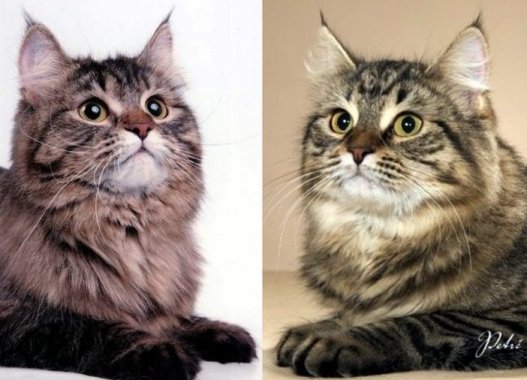
2A. Siberian archetype.
Quite the same cats were used as the examples when the FIFe standard for Siberian cat has been initially adopted (Fig 2B). Surprisingly, but it might be supposed that a number of the people including judges of various systems either forgot or never seen these cats representing the Siberian archetype.
The archetype issue is closely linked to the type description that is in turn intimately related to the breed standard. Indeed, if considering the standard for the native breed, it is worth describing those important traits that highlighted the pre-breed population of indigenous cats rather than to artificially devise certain new features not found (or rarely found) in the original stock. It is logical both from the genetics point of view and taking into account preservation of unique traits of an aboriginal breed that have been developed for centuries. Otherwise, what is the purpose to take and indigenous cats from here and there and make them a breed? In addition, if there are no such features, and one cannot use them as the anchor in describing breed characteristics, no breed can be developed. Such theses are simple, yet often they are overlooked. What is the future SIB breed development, how can it proceed towards extremalization, is broad and separate topic that will be discussed elsewhere in another essay. What is the coloration issue, and why type must prevail over color in the aboriginal breed, is also a matter of separate discussion. Here it can be only pointed out, that whereas the concept of type prevalence has been utilized with tremendous success in SIB's sister breeds, NFC and MCO, it has been often neglected in SIBs themselves. As the result, the race for colors in SIBs has lead to sprawling of Neva Masquerades and cats of other artificial "rainbow" colors. Whether or not it helped to maintain the breed integrity, is obvious from the Fig 3.

2B. Helios Onix Gloria and Tsarevna Cecilia Seliger, cats used as the examples at
FIFe SIB recognition Show in 1997.
This "race over rainbow", that I, otherwise, call "the 90's problem" is responsible for loss of many important brown tabby lines from early 90s (some might remain in US) and for paying little attention to maintenance of the SIB archetype. As such, many breeders, judges, and just future SIB owners especially outside Russia received controversial and sometimes plainly misleading information on how the real Siberian looks like.
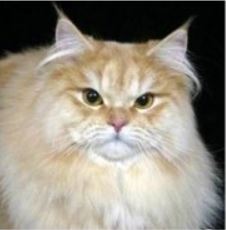 |
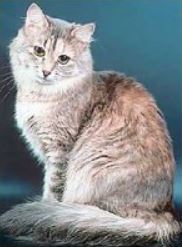 |
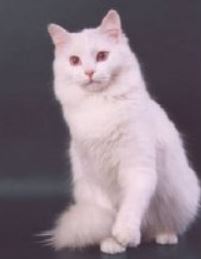 |
 |
| 3. Race over the rainbow. | |||
So, what is the SIB archetype, and which features of this type are needed to be underscored in the standard?
Although the primary feature of a SIB is the head (Fig. 4), and the head determines the overall type and proportions of Siberian and distinguishes SIBs from sister breeds, the coat arrangement is the issue I would like to place in front of all other traits considering current situation. Among some felinologists, the idea circulates that SIB's coat is long and fluffy, and the fluffier the cat, the more "Siberian" it is. By following this idea, very little attention is paid to coat structure, and to peculiarities in the texture of different coat components. It is, however, relatively easy to prove the "fluffy" theory wrong. As the aboriginal cat, the Siberian was evolved to be protected from weather conditions, and from other problems associated with the environment which these cats inhabited for many years. Therefore, the coat must be water repellent, must form descent protective layer that shields animal from wind, cold and rain, as well as disallow burdocks to easily populate the coat while the cat hunts. And the coat is almost completely shedding twice a year. The cat with the cloudy nevershedding coat is by no means a member of SIB's pride.
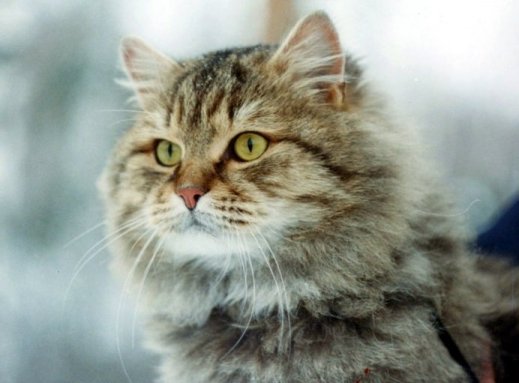
4. A Siberian from Krasnoyarsk, indigenous Siberian lines were crossed with early Moscow lines.
Which type of the coat is perfect? First, the fur hierarchy must be excellently and unambiguously expressed. Rough and glossy guard fur decorates tail, back, and shoulders. This must be supported by thick and rough regular fur that forms compact windshield and heat insulation all over the body. And the undercoat lining must be also thick and compact to prevent easy bur sticking. Finally, too long, thin, and poorly shaped fur (frequently thanks to exceedingly long undercoat) is in disharmony with strong and compact body of a Siberian. One would probably like to see strong excellently balanced wildcat rather than a broiler chicken, finally. Therefore, decorating fur such as frill and, knickerbockers must be pronounced yet compact and accurately shaped rather than scattered and of Persian type (Fig. 5 A and B). I doubt that long fuzz as the decorating fur well coincides with glossy and thick guard hair covering top of the body. In the similar vein, the bulk of decorating fur must be formed by thick and relatively rough regular fur rather than by soft and exceedingly long undercoat-like hairs. The idea regarding triple undercoat in Siberians is generally abandoned now, at least it can be stated so basing on the discussion that took place at the latest IFSJ workshop. The undercoat must be distinctly shorter than regular fur, otherwise the fur looks like fuzzy cotton wool rather than the uniform coat of wild animal. This is especially detrimental for the shape of the tail that appears as a sultan's fan rather than as thick and compact barrel. In addition, silky and long coat usually masks the quality of cat boning making the impression of the medium-sized and finely built cat as of the big and strongly boned one.
| A | B |
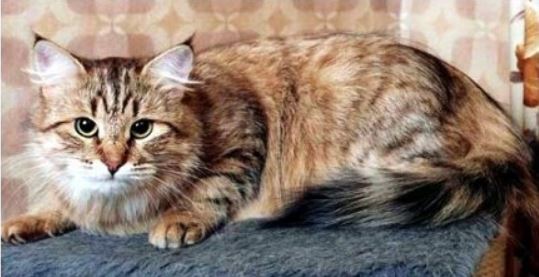 |
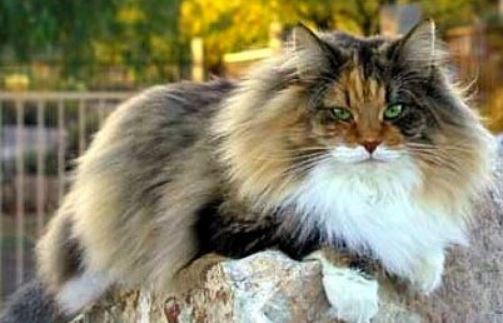 |
| 5. Correct (A) and incorrect (B) coat.(Clarification from PawPeds: picture 5B shows aNorwegian Forest Cat.) | |
The form of the head is another complex and extremely important issue. First and foremost, the head shape is the major trait that makes Siberian a breed and not just a look-alike of NFC and MCO as it has often been stated at the beginning of SIB breeding. I might alienate NFC and MCO breeders, bit in my opinion Siberian-like cats preceded any other semilonghair breeds including not only MCOs and NFCs but also TUAs and TUVs. Wild-like SLH cats most probably originated from Middle East and Transcaucasia, and then spread to different locations in Europe, Siberia, Russia, Asia, and other places. Second, the head type must be in strong coincidence with the body type, which is strong, heavily boned and, in contrast to the sister SLH breeds, is relatively compact. Third, the head type must follow the archetypical Siberian cat and its most likely ancestor, Felis Silvestris Caucasica. Where is the difference between heads of SIBs, NFCs, and MCOs, is clearly seen in Fig. 6. The head of a SIB lacks such extremities as exaggerate whisker pads and muzzle of MCO, and straight profile and overall triangle shape of NFC. But these are well-known features that frequently mask less evident but by no means less important characteristics.
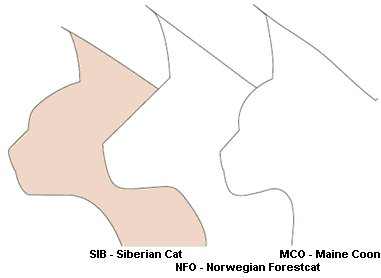
6. SIB, NFC, and MCO.
© Kristin Knudsen and Anne Solveig Berge, Norway.
I often hear a question: what is the so-called trapezoid form of the SIB head? Indeed, when seen straightly enface, the head of a Siberian is in the form of broad modified wedge, as correctly stated in several standards. If the head will be trapezoid from this point of view, this will dictate very broad lower jaw that is obviously impossible. The puzzle is easily solved, however, when a typy SIB is observed from the upper front view. In that case, whisker pads, nose leather, and cheekbones form relatively smooth yet definite line that can be seen as shorter base and sides of a trapezium. The longer trapezoid base is the virtual line drawn across the eye pupils and the nose bridge. Importantly, the smaller base of this trapezium must be sufficiently broad and by no means must it degenerate into a triangle. (Fig. 7A) As the result, the shape of whisker pads in Siberians is at least as important as in Maine Coons. These must be very well filled, but not hanging down or protruding significantly outside the smooth cheekbone line. Hence, transition between whisker pads and cheekbones must be perfectly smooth, without any hint to a pinch, and the breadth of cheekbones must be substantial, otherwise whisker pads will be protruding and disproportional with respect to narrow and high set cheekbones. At the same time, and unlike Persians, Siberians do have substantially protruding muzzle, although it is shorter than the muzzle of MCOs. Too short, bulldog-like muzzle with exaggerate or "hanging down" whisker pads might be a sign of Persian contamination (Fig. 7B).
Apart from lower part of cheekbones and whisker pads, the muzzle is formed by upper and lower jaws. Whereas it is easy to imagine the upper jaw, there is a lot of controversy regarding the shape of chin and the overall form of the lower jaw. Statement regarding weak and recessed chin is the major hurdle. In fact, some felinologists consider that "slanted chin" automatically means "weak jaw". This results in promotion of Siberian cats with extremely froggy jaws. It is not explained, how thin and, in fact, physically weak jaw conducts with the Siberian cat behavior as the dedicated rodent hunter.
Ideally, the slightly recessed, slanted, or, better to say, rounded chin should be maintained in Siberians. This contributes to overall soft contour of Siberian head, and in fact, is in good accord with the archetype. At the same time, the jaw of the hunter cat must be thick, to be in good proportion with massive head, and to underscore the cat's ability to efficiently capture and immediately kill the prey. That pedigreed Siberians lose their ability to hunt, is the common delusion, to say the least. The thin, deeply slanting, froggy jaw is totally unacceptable in a wildcat. Thick, strong jaw with rounded chin supports the correct overall breed presentation and distinguishes SIBs well from sister breeds.
| A | B |
 |
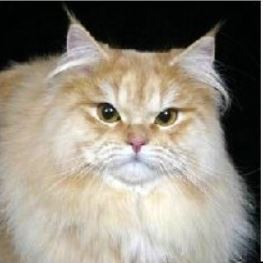 |
| A: Correctly aligned whisker pads form the famous trapezium. |
Persian-like PseudoSiberian with "hanging down" exaggerated whisker pads. |
Eye shape of Siberians is one of the most controversial topics. Different standards describe almost any eye form of Siberian, from "almost round" to "oval". The degree of roundness is not defined. This opens the possibility to various strange interpretations of what is the SIB's eye shape. A point that have been established rather firmly, is that the SIB's eyes must be neither round, nor almond-shaped In fact, if one take closer look at the eye of Siberian, especially on the cats forming relatively stable lines, it is evident, that eye shape is more complex and can be regarded to as the modified, "slightly slanting monk's hood" family of eye shapes. In any case, the upper arc of the eye-socket is shorter, whereas the lower is longer with distinctly pointed form of the outer edge of the eye. What can be an important drawback, to which little attention is paid, is straight line at the inner eye line that distorts the harmonic eye shape (Fig. 8).
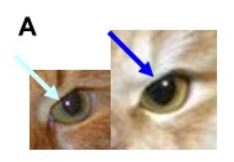 |
 |
| Incorrect (A) and correct (B) shapeof the inner upper corner of the eye. | |
To go into more details regarding original proportions of Siberian's head, some biometric parameters should be mentioned. Biometric analysis of a number of typy cats revealed, that in SIBs, the length of the nose (D1), and the distance between the top of the head and eyebrow line (frontal bone, D2), and the distance between the top of the nose leather and bottom of the chin (D3) are almost identical. This will be very helpful in distinguishing SIBs of correct type from those looking like MCOs (too protruding muzzle and too strong chin), and NFCs, (too straight profile and potentially weaker chin). In the former case, the D3>D2, and in the latter case, D3<D2. If the cat carries some Persian-like features, D1<D2 and D1<D3.
Importantly, if the forehead is not flat, as it must be in Siberians, overall proportions between D1-3 are often distorted. Also, distance between ears is very important. In the existing standards, distance between ears is interpreted too arbitrarily. Although it is usually well-determined, that ears must not be set too high and too close to each other, the maximum distance is usually not defined. As the result, cats with ears set too wide apart are not penalized, moreover they are preferred by some, especially FIFe judges, although most of such cats have Persian-like layout with too small ears set very low and almost buried in the fur. Some biometrics could have been helpful, and the distance between ears is to be set between 1 and 1.5 width of ear base. To do correct estimation, the width of the ear base must be considered as the anatomical item rather than the width of the part of the ear at the place where it is seen above the fur.
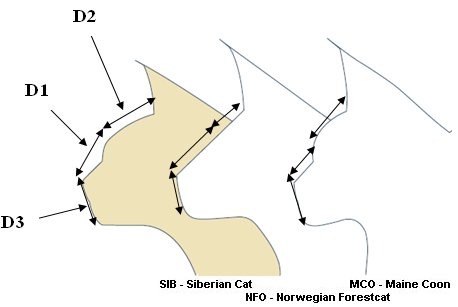
Proportions of the profile in the three forest breeds.
(Drawing is courtesy of Ms Knudsen and Ms A. S. Berge, Norway).
The visible height of the ear would be only slightly more than the width of the ear base. When all these parameters, distance between ears, ear width, and ear height are applied together, it becomes clear that any other type of the ear is almost impossible without introducing severe distortion in the described correlations. In fact, the anatomical ear base (and not the part of the ear visible above the fur) is so wide that if considering a distance between ears significantly more than one ear base, the ears must be positioned almost under the cat's chin close to each other. Again, correlation coefficients could be ideal for the accurate description of SIB standard, but since their official application is still beyond the borders of modern felinology, it is unknown whether these coefficients will be ever included in the SIB standard. The only addition is to be made here is that the Siberian's body (as it seen with the fur) fits well into the "golden section", i.e. the ration of torso height to its length is roughly 1:1.6 (Fig. 10).
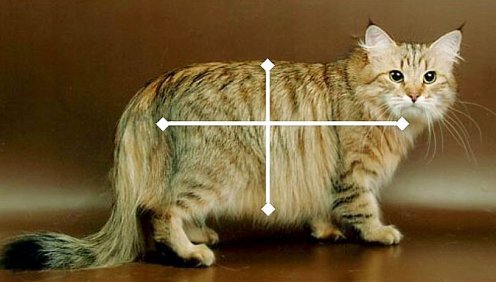
10. Visible body proportions of a Siberian.
What I would also like to mention, is the range and the correlation of the points that affects judging a Siberian. The first and foremost in a SIB is the head, following by muscular well-boned body (unfortunately, fat animals with bad boning are sometimes considered as better comparing to well-boned but normal animals that are seemingly lighter than the overweighed ones). Meanwhile, this is often the case in judging a Siberian, who should be "heavy". The second necessary word in the phrase, i.e. "heavily boned" is oftentimes forgotten. A Siberian with green eyes but moderately developed head and boning is often judges as a superior to the Siberian with excellent type and boning but with yellow or yellow-green eyes. This is simply intolerable. There is a number of delusions of such kind caused by very ambiguous wording in some SIB standards.
Additional work is needed to elaborate correct and unambiguous wording for description of the eye shape and for determination of appropriate penalties in Siberian standard. Yet another "eye issue" is the depth of the eye placement. Sometimes, there is a criticism regarding "too deeply set eyes". Although, it can be correct under some circumstances, a native-like breed cannot have bulging eyes which are again, good indicator of Persian-like type. The odious here is the "sweet facial expression" emerged in some American SIB standards or breed descriptions for unknown reasons. This describes not a native Siberian, but a doll-like cat with round eyes, round face, round everything. Why not to name such a cat as a pet classic Persian instead?
Here we approached some of the crucial points in the vision of what is a Siberian breed. In my opinion based on the observation of good number of SIBs in Russia and abroad, "rounded" and "fluffy" Siberians are sometimes treated as a "substitute" to classic Persians. As the result, there are constant attempts to "converge" the type of Siberian cat with the "Persian" style. Unfortunately, the consequences of such nostalgia can be dire for Siberians. The latter, although having very friendly and often dog-like personality, are not lap animals, but dedicated hunters, incredibly smart, powerful, agile cats with sanguine temperament. Those seeking Persian-like features in Siberians would better turn their attention to other breeds. Those looking a cat for agility competition would probably find in Siberian the best and the smartest agility performer among all cat breeds.
This article is not a SIB standard description, although it might look like this. A number of issues important for the standard remained untouched, some topics, on the contrary, have been described with the degree of detalization that is unnecessary for the standard. No standard of particular European or American system has been taken for direct comparison. In fact, I attempted to present here the review of the discussion that took place in July 2005 when the international society of judges in felinology (IFSJ) held a workshop devoted to regular reviewing and adjusting the Russian Siberian standard. These workshops nowadays gather quite a number of judges and breeders, and, importantly, they are direct successors of consensus statements on Russian native breeds prepared by few enthusiasts almost two decades ago. Some of those enthusiasts are still active members of IFSJ workshops (!). I hope that other systems in the future will pay more attention to the IFSJ SIB standard and derivatives thereof, because it is still largely developed by the same people who actually noticed the now well-known archetype and founded Siberian breed in Russia.
©
Siberian Cat:
Without a Masquerade.
By Alex Kolesnikov, PhD in molecular genetics, Sibaris cattery, Russia.
(Reprinted with permission)
Part III.
Siberian cat, from unknown unknown to known unknown.
Several years ago, I wrote a paper on the potential origins of the Siberian breed. That article has been considered as the first part of certain cycle of articles devoted to Siberian cats. Since then, however, almost five years passed, and neither I, nor anybody with longer experience in Siberians in Russia has managed to continue the cycle of papers available to foreign readers and devoted to this remarkable breed. It is not to blame Russian cat community that nothing has been done to familiarize the rest of the world with "what is going on" in SIBs, but, on the other hand, surprisingly little has been done except of important internal events such as seriously updating the "core original" Russian Siberian standard in 2005, and carrying out several workshops devoted to the future of Siberian breed. This is of course not to mention breeding itself in which some remarkable achievements have been made especially if comparing latest 4-5 years with mid-90s.
Meanwhile, the breed has been spread around the world. Although there are SIB catteries now as far away from Russia as in Malaysia, Australia, and South America, many people are still quite unaware of Siberians even in the good old Europe. Being at European shows, I most frequently hear a question from a casual spectator and even from a breeder with no relation to SLH breeds: "what is this cat"? Fortunately, modern felinology became so popular that most of the show visitors and attendees do understand that they neither see MCO, nor NFC, but something new and still uncommon. It is especially true if considering Siberians with rare colors almost never seen in other SLH breeds, such as e.g. golden.
So, why the article sequels have been shelved for years? Mostly because the integrated picture of the present and future of SIBs lacked in the author's mind. Although it is useful to appeal to the history, the most important is the future of the breed development, and this is not as evident and shining as it should be. And one should be very careful in making statements on the future of such a volatile idea as a cat breed development. Seeing thousands cats, collecting a lot of information, participating in numerous discussions, and in a workshop devoted to the amendment of the original Siberian breed standard, helped me a lot to form more or less consistent view on the current situation and on the future of Siberian breed. That was not possible five years ago, at the times when the consistency of Siberians has been seriously endangered, and any reliable genetic information on SIB breed was lacking.
Siberian standard and Siberian archetype: seeing is believing?
The issues of breed standard and breed development were and can be the subject of quite heated debates. So, in these parts I tried to present facts that can be verified by the members of SIB community with relative ease. Also, I hope that each reader will make his/her own conclusions, and, at the best, fortify them with other proven facts and observations.
What are the most important topics in current development of SIB breed? First and foremost is the correct and consistent interpretation of the standard by all the breeders. As a young breed with old aboriginal roots, representing different lines in different locations both in Russia and abroad, Siberian cat needs clear identification of an archetype and building the archetype features into the standard. The standard itself and explanation of its peculiarities are highly important for such a native breed as Siberians. In view of this, I wrote a separate article devoted exclusively to that topic and based on the workshop held in 2005 and devoted almost exclusively to the SIB standard. This will be the part three and the final one to this moment of the SIB essay. As such, I will not consider the standard issues deeply in this part, however, some overlapping between the articles will be inevitable for the purpose of better understanding. The second topic logically ensuing from the breed youth is the problem of the breed consistency and the ways of the breed stabilization. And it is the issue currently severely hampering breed development both inside and outside Russia. Systematic breeding of SIBs started only 20 years ago, but it has been already experienced significant problems. The following issues impeding certain aspects of SIB development, especially for foreign breeders are:
- the "on default" consideration that 20 years ago, the SIB breed has been started not by amateur Argonauts rushed into a felinological fleece search, but by the felinology professionals
- yet another belief that the cats from two Russia's capitals indeed formed the Siberian breed, and
- the belief that cats imported decades ago from Russia can be used for development of modern SIBs as successfully as their remote descendants. With failure of such attempts, an opinion that SIBs lack any archetype has become widespread in certain breeder's circles
If not investing a lot of time in thorough research of pedigrees, one can express the common view that almost all the initial SIB gene pool originates from St. Petersburg and from Moscow. This view is, however, not correct. If speaking about sheer numbers, yes, one can say that more than 90% of the initial foundation population came from these two cities. (This is not taking into account cats that have been brought to Germany during last decade of USSR and later have been recognized as SIBs). But if speaking about the impact of certain lines on modern Siberians, it readily becomes evident that some foundation cats having greatest influence of further development of SIBs as the consistent breed, are in fact originating from outside Moscow and St. P. Famous Abakans (Amur, Aldan, and Argo), or to say more precisely, their immediate ancestry, came from Siberia and Far East. These males can be found in maybe half of pedigrees of Moscow's SIBs, and they are of obvious Siberian and Far East origins. In general, a number of excellent and even outstanding SIBs have been born as the result of crossing Moscow lines and those from Siberia and Far East. Examples are not limited to the early Abakan line, but also represent Irdie (Treskuchii Sibirskii Moroz Mur), Busik and his offspring from Krasnoyarsk, and some other cats. This observation strongly suggests the existence of certain archetype in Siberians,that can be partly hidden in local populations, but is immediately revealed after quite a plethora of outcrosses between cats from different locations (Fig 1.)

1. The Siberian archetype.
Pedigrees of these females can be found at URLs:
http://www.pawpeds.com/db/?a=p&id=293706&g=4&p=sib&date=iso&o=ajgrep (for the cat on the left), and
http://www.pawpeds.com/db/?a=p&id=218781&g=4&p=sib&date=iso&o=ajgrep (for the cat on the right).
This observation is very important because it provides genetic proof of the concept at which early description of Siberian cat has been built. More archetype description will be available in the Part three, here in Fig 1. three male cats are presented that have been born at different places and from partially or significantly different parents. All, however, have some common lineage, although it can be very remote (once in the 5th generation for male 2 and male 1, for example). Importantly that all the males born more than 10 years ago, and all the ancestors in their pedigrees other than those from the Abakan line (or pre-Abakan cats in male 2) are totally different.
Yet another pair of photos depicts two females with so distant relatives in the ninth knee of the pedigree. These females were born about five thousands kilometers apart, and none of their relatives ever met... except of the pre-Abakan cats originating from Siberia and Far East. These examples are given only for the purpose of explaining why not numbers but gene combinations are important to claim the actual participation in the breed foundation. In addition, these examples indicate the Siberian cat archetype that could not been eradicated despite lack of systematic breeding in a number of catteries during early ninetieth.
Neva Cats: no Ace Ventura behind the Mask.
The third topic is the problem of Neva Masquerades and their relatedness to Siberians. This topic is actually a part of the previous one, and all the beliefs described above count for this very issue. Neva Masquerades have been accepted as a color variety of Siberian breed in a number of cat associations such as WCF, CFA, TICA etc. Main grounds of acceptance were arbitrarily described as "long persistence of said color variety among aboriginal semilonghair cats in Russia". No genetic analysis and analysis of actual origins of Neva cats was possible at the time of recognition. Participation of SLH colorpoint cats from the very beginning of SIB breed in Saint Petersburg (without careful analysis of their origins) has been considered as sufficient ground for inclusion of Nevas into the forming Siberian breed. Let us (with huge delay, but there is some excuse for that as a reader can understand from this article) try to perform at least part of such analysis in order to better understand the roots of Neva Masquerades.
Current Russian felinology is very competitive with a number of excellent cats and catteries of variety of breeds, known both nationally and internationally. Not only Siberians are recognized in all major cat associations in the world, but several other Russian native breeds have emerged, such as Don sphinxes, Kurilean bobtails, and few other, less known. One currently observing Russian felinology, but lacking the insight of experts as well as the insider's knowledge of situation 15-20 years ago, can infer that it was in the same state during those days, just like in their own (read Europe, US/Canada/Australia etc) country. Such a view will be a big mistake. I read at some websites of SIB catteries abroad that "in USSR cats were not allowed due to food shortage". This statement is funny, but not more than the assumption on experienced and well-developed Russian felinology 20 years ago. Luckily, acknowledgment of the SIB archetype was one the most important achievement of early breeders and cat judges. At that time, they did not compile comprehensive breed standard, and the SIB standard underwent a number of corrections during the past years. However, they captured the breed's archetype features common both for big cities and for Siberian backwoods.
Despite this success, the background at which SIBs and Nevas emerged was obviously formed by amateurs. Nowadays in Russian felinological media it is the "le ton mauvais" to remind about lack of systematic education of first Russian felinologists and to refer to actual origins of colorpoint "Siberians". It has become especially true since heated debates between anti-Neva and pro-Neva Big-endians and Little-endians taken place 3-4 years ago. I tend to express an irony here (courtesy to Jonathan Swift) because the arguments in those debates drawn by both sides were mostly senseless and ridiculous. For not to be unsubstantiated, I will just mention that the persons argued for making separate breed basing on Nevas have been accused in the attempts to "eliminate Nevas because they started to win over traditional Siberians at shows". It is interesting, however, why those pesky "Neva Terminators" haven't been suspected in "elimination" of other competing SLH breeds such as MCOs, NFCs, TUAs etc etc. On the serious and regrettable side, those debates have led to attempts to hide facts about origins of Nevas. As a result, and a number of myths has been summoned to legitimatize Nevas as true and genuine Siberians. Although analysis of myths created 3-5 years ago it is not particularly interesting task (not as interesting as for the myths survived millennia of human history), it is what we need in order to understand the Neva origins, and trends of SIB breed development.
The primary idea was that "colorpoint semilonghair cats have been present in Russia in numbers for centuries, together with other cats". As the "evidence", a case of so-called "Pallas cat" is frequently cited. Indeed, Pallas observed a colorpoint cat near Mokshan town (Volga river) in 1793 (Fig. 2A).
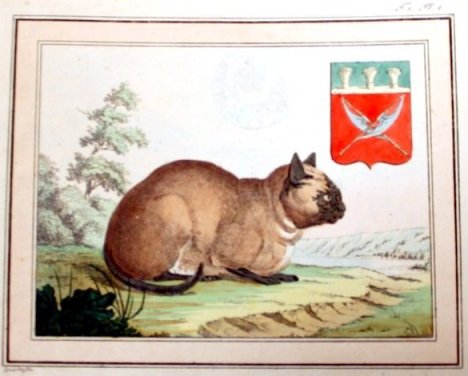
2A. Pallas cat.
On the basis of this observation, it has been "concluded" that colorpoint cats have been in Russia in abundance for centuries. However, close examination of this nice drawing obviously shows us classic apple-headed shorthair Thai cat (Fig. 2B, C), whose origin at South-East Asia is well-known and now is out of debates (see below). So, if trying to infer origins of Nevas from Pallas-like cats, Neva cat will not loose its origin as the outcross of Russia's indigenous cat and a Thai cat.
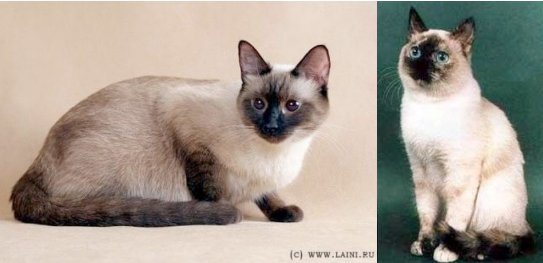
2B, C. Modern Thai cats from Russia.
Let us refer to some sources of first-hand information by opening the book of Olga Mironova, "Aboriginal cats of Russia" issued in 2003, pages 29-31. This part of the book is devoted to Neva Masquerades. At the beginning of the chapter, Mironova absolutely openly admits that "It happened so that Siberian cats became a kin to proliferated offspring of Siamese (Thai - A. K.) cats imported to us from abroad by distinguished director of Puppet Theatre, Sergey Obraztsov" [1]. As we all understand, puppets and puppet theatres play significant role in the life of Russia and other countries as well, however, it cannot be considered as a reason to accept the outcrossed breed "Neva Masquerades" as Siberians.
Was the Obraztsov's case (Moscow) of importing colorpoint cats to Moscow a single one? Of course, it was not. Maybe even the import of parent(s) of "Pallas" (not to mix with true Pallas Cat, that is, Felis manul) cat by Volga's basin merchants wasn't the first one. Cats of unusual color did attract the attention of wealthy people at any times, so it is not surprising that some Thai cats entered Russia centuries ago. However, this caused no reflection on Siberian kin at those times since even the sources describing notable (and quite expensive) Bukhara cats, close relatives of Siberians but imported from Central Asia by roughly the same Volga basin routes and thus had more chances to meet Thai cats than any other Russian cats of that era, speak about brown tabbies and keep absolute silence about Bukhara (or Zeravshan, that is a nearby river -A. K.) Masquerades [3].
Thai cats were popular in Soviet Union, especially after establishing of closer relations with Indochina's countries at late 60s. My uncle lived in Caucasus was proud owner of Thai cat since 1972. That was typical colorpoint apple-headed shorthair cat with kinked tail brought from Vietnam by oil geologists. Of course, main ports, St. Petersburg and Vladivostok were primary gates of entering Thai cats to Russia during those times. That is the most natural explanation on why, the cp gene is abundant in these cities, especially in St. Petersburg, but is rare or absent in the rest of Russia (except of Moscow that is and was the center of everything).
Description of Neva Masquerades as the outcross between Thais and Siberians was given by several authors in a felinological media of Russia and former Soviet Union. Only after the "Endians'" wars took place in ca 2004, it has become politically incorrect to mention the origins of Nevas, and since then Mironova's book has been cited only partially, e.g. "true Siamese, Balinese, and Himalayan cats entered Russia long after recognition of Nevas, and have never been used in development of Neva Masquerades" (ibid, p.30). Also, some citations of well-known Siberian breeders have been rapidly forgotten. T. E. Pavlova wrote in 2002 in the Ukrainian "Tvoya Koshka" (Your Cat) magazine: "First emerging in St. Petersburg, Neva Masquerades immediately attracted public attention. Characteristic features taken from Thai (old-type Siamese) did not impair the type of Siberians, but rather introduced refined charm and exotic into the breed".
Following Mironova's text, I mentioned Balinese cats. Here we are approaching one of the culprits of this story, i.e. how and why quite a number of colorpoint cats have become Neva Masquerades in a short period of time. I am watching a videotape record from a cat show of now dissolved cat club "Soyuz" taken place in ca 1994. I see many famous SIBs there, Svetik, Bukashka, Knyaz Vasiliy, and some others. At the same time, I see proud couple holding huge and muscular colorpoint SLH cat saying "And it is our Balinese". Nowadays this big cat could have been referred to as Neva Masquerade with almost 100% confidence. Let us return to the "Aboriginal cats of Russia". "During first cat shows, SLH cats of Siamese color have been inscribed for breed recognition. They (as a rule - A. K.) have been immediately ascribed to Neva Masquerades. Sometimes owners of such cats described them as Balinese by themselves... I have been forced to make a description of these cats as domestic ones, or as Neva Masquerades if they deserved that". However, first shows have been held at the late 80s, and the show we are discussing here has been held not earlier than at the end of 1993 according to participating Siberian cats whose registration dates are known. Therefore, times when owners could "describe the cat by themselves" have already been well in the past. And of course these "Balineses" occurred due to acceptance of inexperienced "judges". Actually there is nothing unusual in the mentioned "Balinese" case. "Transferring" of "Balineses" to Nevas at the end of 80s is described in colors in the online article of WCF Judge Irina Sadovnikova and is supported by citing appropriate pages from the cat show catalog (see Ref. 6 and Appendix II, respectively). Russian felinology matured only relatively recently, and at the beginning there was common trend to create own "replicas" of well-known foreign breeds because Western prototypes were out of reach for Soviet and then Russian cat fancy due to financial, communication, and other reasons. At the beginning, "homemade" Norwegian forest, Siamese, Balinese, European Shorthair (the latter with more rights to exist in Russia) occupied significant part of cat shows.
What was the reason to this? Obviously, the reason was mostly financial because kittens of the "rare breed" could have been sold with much more success than e.g. brown tabby SLH "alley" cats. Also, there was great desire of significant part of young cat fancy to see their household pets as "pedigreed" cats. To the current situation, occurrence of these "Balinese" cases just mean that quite a number of colorpoint SLH cats later became Neva Masquerades have the origins other than occasional outcrosses of Thai cats with Russia's alley cats in 60s-80s.
Spread of colorpoint mutation: growing a needle in the haystack.
In the book, Mironova says about "recent explosion" in numbers of cp "SIBs". Let us analyze, can this explosion occur due to natural reasons such as plain increase in the number of catteries, increase in guided breeding events etc. That the colorpoint mutation is present in all mammals is a Punchinello's Secret. However, in most of the populations this mutation is extremely rare. Despite all the power of modern molecular biology, it is still only one case of unequivocal detection of "Siamese" mutation in Humans [2]. Cats from Southeast Asia represent unique mammalian pool in which this mutation is abundant. In other cats is as rare as in the rest of the mammals.
It is known that colorpoint mutation is present in the well-known Abakan line whose ancestors are cats from the Abakan cattery, Amur, Aldan, and Argo Abakans and some relatives of their parents. The known carrier of this mutation was Mura, the foundation cat of the De Glemur cattery. Mura, born in the mid 80s, herself has no relevance to Abakans, it is Moscow-originated cat that could acquire cs gene from e.g. Thai cats or their descendants. Despite abundant presence of Mura in pedigrees of Moscow-bred cats, only a handful of colorpoint cats were born within these lines, some in Moscow, some in Finland, some in US and some in Poland. To the best of my knowledge, during ca 15 years of breeding within these lines, less than ten litters containing colorpoint kittens was born. Of course, when these colorpoint kittens were used with other colorpoints in purposeful breeding, the numbers increased. But if speaking about spontaneous emergence of colorpoints (and breeding of Mura's offspring for many years represents unique experiment because that breeding had no purpose to select colorpoint cats among other colors), the percentage appears to be very low. Thus, the reasons for "explosion" in the numbers of colorpoint cats during early 90s is anything else but plain increase of numbers of cp kittens among already existing Siberian lines during breeding. One of the reasons is selection for "Balinese" cats and further re-determination of many of these "Balineses" as Neva Masquerades. It is now not known which XLH cats were used to generate "Balineses", but it is quite obvious they had little relevance to Siberians simply because "Balinese" catteries did not care about that. Another source was of course outcrosses, purposeful or occasional. There is some evidence of crossing Siberians with Persians in "experimental" pedigrees of some Russian clubs (Fig 3.), but unequivocal evidence is lacking if those crosses yielded any colorpoint cats further used in breeding. Although there is a lot of rumors regarding deliberate use of Persians and Thai cats during early to mid 90s to "create" new lines of Nevas, direct evidence of such actions is currently lacking. Either pedigrees reflecting these events have been later "cleansed" or the trend was not mass, especially taking into account already maturing felinological community.
Concluding remarks.
Basing on the above material, the following conclusions can be made regarding origins and spread of Neva Masquerades:
There were several waves of Nevas entering the Siberian breeding pool, each originating under certain unique circumstances, and thus having unique genetic background. First wave emerged at the end of 80s when a number of fancy colored cats of Moscow and St. Petersburg have been recognized as Siberians because they "were the product of Mother Nature breeding between Russian aboriginal and Thai cats". Only recent genetic analysis has shed some light on the difference between "Mother's Nature" genetic background and the resulting mixed genotype. Second wave came with rise and fall of Balinese cats of Russian vintage when the Russian felinological community grew out of its infancy and realized that their Balinezski, Norwezhski, and Siamski will never be accepted by the rest of the world. The third wave was rather a ripples caused by occasional attempts to "increase the numbers" and "broaden the genepool" of Siberians by outcrossing them with Persians.
During almost all the time except of very recent years, there was open acceptance of the fact published in books as well as in periodical media that Neva Masquerades emerged in big cities as the outcross of Thai and Russia's native SLH cats mostly during the second half of XX century. Such open acceptance, however, rapidly faded when certain part of the developing Russian felinological community tried to impeach the idea of identity between Nevas and traditional Siberians.
The argumentation on the long-term existence of colorpoint cats in Russia cannot be accepted because these cats did not left any detectable trace in history and folklore except of Pallas' drawing of Thai-looking cat. On the contrary, Bukhara cats being close relatives (or maybe even ancestors) of modern Siberians have been described as cats of wild-type coloration [2]. Till now big, "fluffy" and "grey-striped" cats in Southern Urals region, Moslem autonomous republics of Russia, and Central Asian countries are called as "Bukhara", and not "Siberian" cats. This is important because the population of Bukhara cats had much more chances to encounter cats from South-East Asia brought there via prolific merchants' routes, than any of the cats living on Russia's territory. Garteveld [3] indicates that the price of a pair of Bukhara cats is "75-100 rubles, and here (in Asia - A. K.) they are not significantly cheaper than in Moscow". The sum of 100 rubles at the beginning of XX century in Russia was approximately one-half to one-third of the annual salary of a worker or a clerck. It is unlikely that the presence of other remarkable cats such as colorpoints at Russian or neighboring markets would have been passed without a trace.
As cited above, the main basis for "legitimizing" Neva Masquerades as part of Siberians is as follows:
- outcrosses of Russian SLH cats with Thai cats occurred before breed recognition, and
- Thai cats already represent the pool of Russia's indigenous cats.
Both statements are, however, proved wrong. Quite a number of outcrosses of colorpoint cats with those genetically and phenotypically irrelevant to Siberians occurred years after SIB and Neva recognition, and initially had no purpose to generate Neva Masquerades, but rather to breed "Balineses". Only with growing understanding of this way of breeding as the wrong one, significant part of these cats was "transferred" to Neva Masquerades in ca 1992-1995.
The most important is that recent molecular genetic analysis unequivocally demonstrated that Siamese clade of cats (in which Thai cats represent one of the archetypes) is genetically most distant from the rest of the cat breeds as well as from European and Mediterranean alley cats [4]. Siberian cats included in that study represent no exception and are located at the opposite branch of this genetic tree. Importantly, this analysis concerns not colorpoint and non-colorpoint cats, but cats of SEA and other regions regardless of the color. For example, Korats included in that analysis have been shown to genetically belong to the SEA clade and appeared as distant from other cats as their colorpoint cousins [5].
This data indicates that cats of SEA region have been geographically separated from the rest of the domestic cat population for quite a while, and acquired unique structure of the genome. It is therefore little sense in crossing the animals (Thais and Russian SLH cats) that are as genetically distant as it is possible within the evolutionary tree of domestic cats, and in declaring such an outcross to be "natural" and "useful". In fact, massive outcrossing of genetically distant cat populations inevitably results in loss of the unique traits of both clades. Instructively, it is what occurred with Persians, probably the most advanced breed, if speaking about extremalization and development of artificial traits in pedigreed cats. Although there are little doubts in the historical origins of Persians from Iran and Middle Asia, and close relatives of these cats, Angoras and Vans indeed possess region-specific features in DNA, whereas Persians lost them completely. Persians are thus representing a stark example of what happens with the genetic background of a breed if breeding proceeds only towards the desired artificial-looking extreme type paying no attention to how this type has been achieved. What is fully permissible in the case of an artificial breed is totally unacceptable, if speaking about preservation of genetic uniqueness of a native breed such as Siberians.
Why rapid loss of unique genetic background is inevitable in Siberian-Thai pointed outcrosses aimed at propagation of colorpoints? It is because the colorpoint gene is recessive. It is relatively easy to introduce a dominant trait (e.g. silver color) into a cat population while largely preserving the genotype of this population. Since dominant trait is always "visible", it can be bred into a cat population by using single ancestor and by monitoring the trait by eye. During several generations of breeding, each time with the cat that represents new member of the said population, the traits "imported" with the desired dominant one are gradually "washed out" of the population. The only thing needed to make such a genetic "laundering" highly efficient is to remove all the "intermediate" cats from breeding.
On the contrary, in order to perform "clean" breeding-in a recessive colorpoint gene into a cat population, one should have understanding of molecular genetics, and be ready to invest considerable funds into performing at least several tens (better hundreds) DNA tests. One can afford seamless introduction of recessive gene into new background, according to the above scheme, only using strict control of heterozygotes at each breeding step. These heterozygous cats containing normal and colorpoint alleles will lack colorpoint phenotype, and their genotype must be revealed by DNA test (polymerase chain reaction, PCR).
There are some unpublished indications that the genome of Siberian cats contains DNA sequences uncommon in other breeds. For example, Siberians are thought to cause less allergic reactions comparing to any other cat breed. Whether it is indeed the case, remains to be investigated, but spread of foreign genes from Thai and other colorpoint-carrying cats in Siberian population can rapidly eliminate the opportunity to know if there was a real molecular mechanism behind this.
Additional study is needed to confirm these initial findings, but if consider unrestricted breeding of Siberian cats with Neva Masquerades already containing significant proportion of non-native genetic material, the uniqueness of Siberian genome is at risk to never been described.
In my opinion, consequences of introduction of Neva Masquerades in Siberians are quite obvious. In Russia, despite all debates the trend to breed Nevas and Siberians separately has never changed and only a small fraction of catteries practices the opposite. Hope that the information presented in this paper will be useful for current and future Siberian breeders worldwide.
References
[1] http://www.britannica.com/eb/article-9056655/Sergey-Vladimirovich-Obraztsov
[2] http://www.jci.org/articles/view/115075
[3] Garteveld V. I. Amidst loose sands and cut throats. Moscow, 1913
[4] http://www.pubmedcentral.nih.gov/articlerender.fcgi?artid=2267438
[5] http://www.pubmedcentral.nih.gov/picrender.fcgi?artid=2267438&blobname=nihms-37932-f0002.jpg
[6] http://cat-sibiryak.ru/st-Sadovnikova1.htm
Appendices
Fragment of "experimental" pedigree of "Siberian" containing Persian cat:
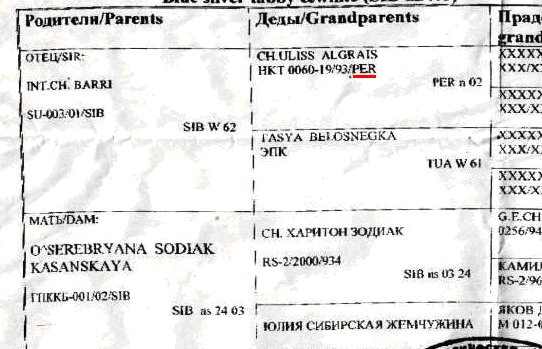
Cover of the book cited under Ref. 3:
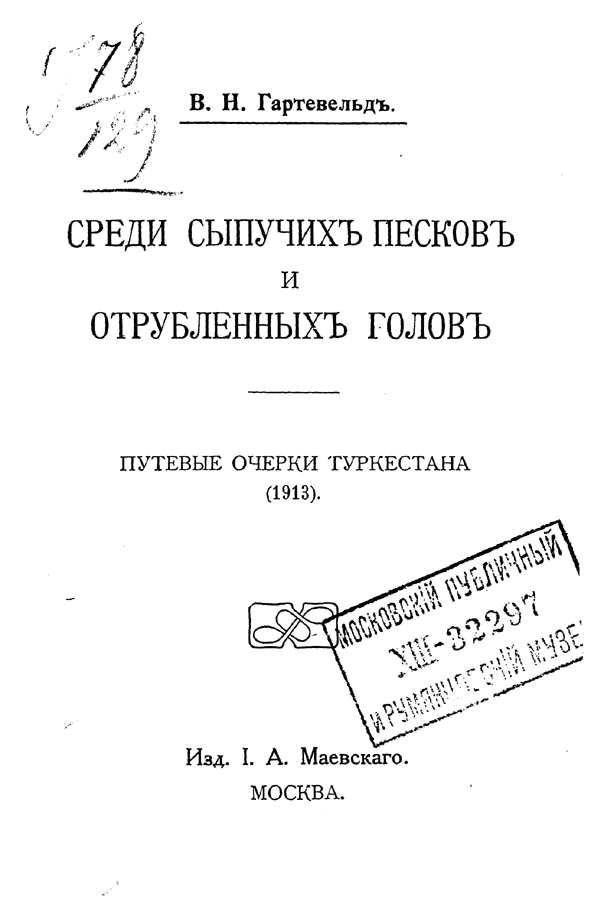
Pages from show catalogues for shows held in Latvia and in Russia.
"Balineses of novice class" are highlighted with red line:
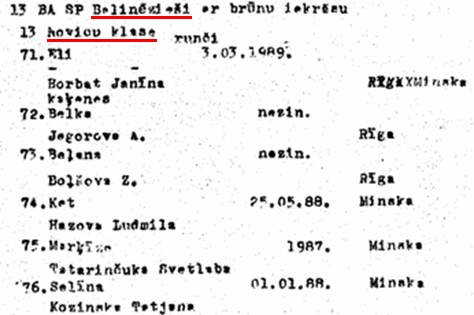 |
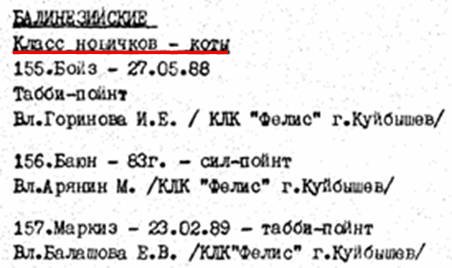 |
©
